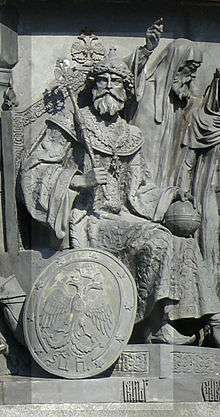History of Russia
The history of Russia begins with the histories of the East Slavs.[1][2] The traditional start-date of specifically Russian history is the establishment of the Rus' state in the north in 862 ruled by Vikings.[3] Staraya Ladoga and Novgorod became the first major cities of the new union of immigrants from Scandinavia with the Slavs and Finno-Ugrians. In 882 Prince Oleg of Novgorod seized Kiev, thereby uniting the northern and southern lands of the Eastern Slavs under one authority. The state adopted Christianity from the Byzantine Empire in 988, beginning the synthesis of Byzantine and Slavic cultures that defined Orthodox Slavic culture for the next millennium. Kievan Rus' ultimately disintegrated as a state due to the Mongol invasions in 1237–1240 along with the resulting deaths of about half the population of Rus'.
Part of a series on the |
||||||||||||||||||||||||||||
|---|---|---|---|---|---|---|---|---|---|---|---|---|---|---|---|---|---|---|---|---|---|---|---|---|---|---|---|---|
| History of Russia | ||||||||||||||||||||||||||||
.svg.png) 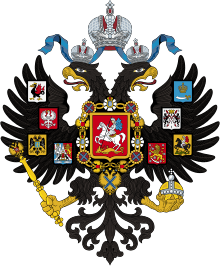   | ||||||||||||||||||||||||||||
|
||||||||||||||||||||||||||||
| Timeline | ||||||||||||||||||||||||||||
|
| ||||||||||||||||||||||||||||

After the 13th century, Moscow became a cultural center. The territories of the Grand Duchy of Moscow became the Tsardom of Russia in 1547. In 1721 Tsar Peter the Great renamed his state as the Russian Empire, hoping to associate it with historical and cultural achievements of ancient Rus' – in contrast to his policies oriented towards Western Europe. The state now extended from the eastern borders of the Polish–Lithuanian Commonwealth to the Pacific Ocean. Peasant revolts were common, and all were fiercely suppressed. The Emperor Alexander II abolished Russian serfdom in 1861, but the peasants fared poorly and revolutionary pressures grew. In the following decades, reform efforts such as the Stolypin reforms of 1906–1914, the constitution of 1906, and the State Duma (1906–1917) attempted to open and liberalize the economy and political system, but the Emperors refused to relinquish autocratic rule and resisted sharing their power.
A combination of economic breakdown, war-weariness, and discontent with the autocratic system of government triggered revolution in Russia in 1917. The overthrow of the monarchy initially brought into office a coalition of liberals and moderate socialists, but their failed policies led to seizure of power by the communist Bolsheviks on 25 October 1917 (7 November New Style). Between 1922 and 1991 the history of Russia became essentially the history of the Soviet Union, effectively an ideologically-based state roughly conterminous with the Russian Empire before the 1918 Treaty of Brest-Litovsk. The approach to the building of socialism, however, varied over different periods in Soviet history: from the mixed economy and diverse society and culture of the 1920s through the command economy and repressions of the Joseph Stalin era to the "era of stagnation" from the 1960s to the 1980s. From its first years, government in the Soviet Union-based itself on the one-party rule of the Communists, as the Bolsheviks called themselves, beginning in March 1918.
By the mid-1980s, with the weaknesses of Soviet economic and political structures becoming acute, Mikhail Gorbachev embarked on major reforms, which eventually led to the overthrow of the communist party and the breakup of the USSR, leaving Russia again on its own and marking the start of the history of post-Soviet Russia. The Russian Federation came into being in January 1992 as the legal successor to the USSR. Russia retained its nuclear arsenal but lost its superpower status. Scrapping the socialist central planning and state-ownership of property of the socialist era, new leaders, led by President Vladimir Putin (who first became President in 2000), took political and economic power after 2000 and engaged in an energetic foreign policy. Russia's 2014 annexation of the Crimean peninsula has led to economic sanctions imposed by the United States and the European Union.
Prehistory
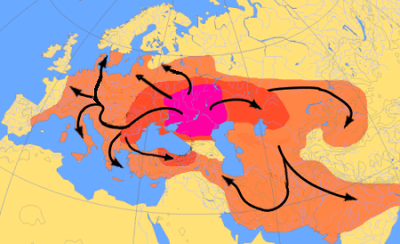
In 2006, 1.5-million-year-old Oldowan flint tools were discovered in the Dagestan Akusha region of the north Caucasus, demonstrating the presence of early humans in Russia from a very early time.[4] The discovery of some of the earliest evidence for the presence of anatomically modern humans found anywhere in Europe was reported in 2007 from the deepest levels of the Kostenki archaeological site near the Don River in Russia, which has been dated to at least 40,000 years ago.[5] Arctic Russia was reached by 40,000 years ago. That Russia was also home to some of the last surviving Neanderthals was revealed by the discovery of the partial skeleton of a Neanderthal infant in Mezmaiskaya cave in Adygea, which was carbon dated to only 29,000 years ago.[6] In 2008, Russian archaeologists from the Institute of Archaeology and Ethnology of Novosibirsk, working at the site of Denisova Cave in the Altai Mountains of Siberia, uncovered a 40,000-year-old small bone fragment from the fifth finger of a juvenile hominin, which DNA analysis revealed to be a previously unknown species of human, which was named the Denisova hominin.[7]
During the prehistoric eras the vast steppes of Southern Russia were home to tribes of nomadic pastoralists. In classical antiquity, the Pontic Steppe was known as Scythia.[8] Remnants of these long gone steppe cultures were discovered in the course of the 20th century in such places as Ipatovo,[8] Sintashta,[9] Arkaim,[10] and Pazyryk.[11]
Antiquity
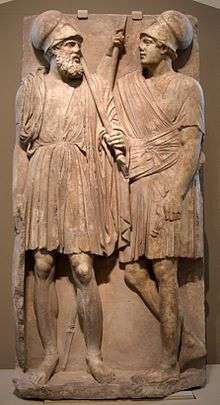
In the later part of the 8th century BCE, Greek merchants brought classical civilization to the trade emporiums in Tanais and Phanagoria.[12] Gelonus was described by Herodotus as a huge (Europe's biggest) earth- and wood-fortified grad inhabited around 500 BC by Heloni and Budini. The Bosporan Kingdom was incorporated as part of the Roman province of Moesia Inferior from 63 to 68 AD, under Emperor Nero. At about the 2nd century AD Goths migrated to the Black Sea, and in the 3rd and 4th centuries AD, a semi-legendary Gothic kingdom of Oium existed in Southern Russia until it was overrun by Huns. Between the 3rd and 6th centuries AD, the Bosporan Kingdom, a Hellenistic polity which succeeded the Greek colonies,[13] was also overwhelmed by successive waves of nomadic invasions,[14] led by warlike tribes which would often move on to Europe, as was the case with the Huns and Turkish Avars.
A Turkic people, the Khazars, ruled the lower Volga basin steppes between the Caspian and Black Seas through to the 8th century.[15] Noted for their laws, tolerance, and cosmopolitanism,[16] the Khazars were the main commercial link between the Baltic and the Muslim Abbasid empire centered in Baghdad.[17] They were important allies of the Byzantine Empire,[18] and waged a series of successful wars against the Arab Caliphates.[15][19] In the 8th century, the Khazars embraced Judaism.[19]
Early history
Early East Slavs
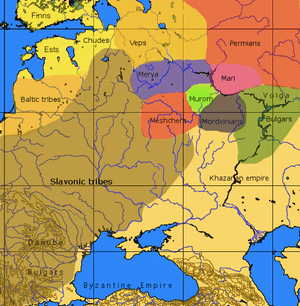
Some of the ancestors of the modern Russians were the Slavic tribes, whose original home is thought by some scholars to have been the wooded areas of the Pripet Marshes.[20] The Early East Slavs gradually settled Western Russia in two waves: one moving from Kiev towards present-day Suzdal and Murom and another from Polotsk towards Novgorod and Rostov.[21]
From the 7th century onwards, East Slavs constituted the bulk of the population in Western Russia[21] and slowly but peacefully assimilated the native Finno-Ugric tribes, such as the Merya,[22] the Muromians,[23] and the Meshchera.[24]
Kievan Rus' (882–1283)
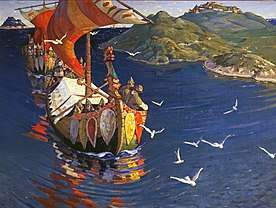
Scandinavian Norsemen, known as Vikings in Western Europe and Varangians[25] in the East, combined piracy and trade throughout Northern Europe. In the mid-9th century, they began to venture along the waterways from the eastern Baltic to the Black and Caspian Seas.[26] According to the earliest Russian chronicle, a Varangian named Rurik was elected ruler (knyaz) of Novgorod in about 860,[27] before his successors moved south and extended their authority to Kiev,[28] which had been previously dominated by the Khazars.[29] Oleg, Rurik's son Igor and Igor's son Sviatoslav subsequently subdued all local East Slavic tribes to Kievan rule, destroyed the Khazar khaganate and launched several military expeditions to Byzantium and Persia.
Thus, the first East Slavic state, Rus', emerged in the 9th century along the Dnieper River valley.[27] A coordinated group of princely states with a common interest in maintaining trade along the river routes, Kievan Rus' controlled the trade route for furs, wax, and slaves between Scandinavia and the Byzantine Empire along the Volkhov and Dnieper Rivers.[27]
By the end of the 10th century, the minority Norse military aristocracy had merged with the native Slavic population,[30] which also absorbed Greek Christian influences in the course of the multiple campaigns to loot Tsargrad, or Constantinople.[31] One such campaign claimed the life of the foremost Slavic druzhina leader, Svyatoslav I, who was renowned for having crushed the power of the Khazars on the Volga.[32] At the time, the Byzantine Empire was experiencing a major military and cultural revival; despite its later decline, its culture would have a continuous influence on the development of Russia in its formative centuries.
.png)

Kievan Rus' is important for its introduction of a Slavic variant of the Eastern Orthodox religion,[27] dramatically deepening a synthesis of Byzantine and Slavic cultures that defined Russian culture for the next thousand years. The region adopted Christianity in 988 by the official act of public baptism of Kiev inhabitants by Prince Vladimir I, who followed the private conversion of his grandmother.[33] Some years later the first code of laws, Russkaya Pravda, was introduced by Yaroslav the Wise.[34] From the onset, the Kievan princes followed the Byzantine example and kept the Church dependent on them, even for its revenues,[35] so that the Russian Church and state were always closely linked.
By the 11th century, particularly during the reign of Yaroslav the Wise, Kievan Rus' displayed an economy and achievements in architecture and literature superior to those that then existed in the western part of the continent.[36] Compared with the languages of European Christendom, the Russian language was little influenced by the Greek and Latin of early Christian writings.[27] This was because Church Slavonic was used directly in liturgy instead.[37]
A nomadic Turkic people, the Kipchaks (also known as the Cumans), replaced the earlier Pechenegs as the dominant force in the south steppe regions neighbouring to Rus' at the end of the 11th century and founded a nomadic state in the steppes along the Black Sea (Desht-e-Kipchak). Repelling their regular attacks, especially in Kiev, which was just one day's ride from the steppe, was a heavy burden for the southern areas of Rus'. The nomadic incursions caused a massive influx of Slavs to the safer, heavily forested regions of the north, particularly to the area known as Zalesye.
Kievan Rus' ultimately disintegrated as a state because of in-fighting between members of the princely family that ruled it collectively. Kiev's dominance waned, to the benefit of Vladimir-Suzdal in the north-east, Novgorod in the north, and Halych-Volhynia in the south-west. Conquest by the Mongol Golden Horde in the 13th century was the final blow. Kiev was destroyed.[38] Halych-Volhynia would eventually be absorbed into the Polish–Lithuanian Commonwealth,[27] while the Mongol-dominated Vladimir-Suzdal and independent Novgorod Republic, two regions on the periphery of Kiev, would establish the basis for the modern Russian nation.[27]
Mongol invasion and vassalage (1223–1480)
The invading Mongols accelerated the fragmentation of the Rus'. In 1223, the disunited southern princes faced a Mongol raiding party at the Kalka River and were soundly defeated.[39] In 1237–1238 the Mongols burnt down the city of Vladimir (4 February 1238)[40] and other major cities of northeast Russia, routed the Russians at the Sit' River,[41] and then moved west into Poland and Hungary. By then they had conquered most of the Russian principalities.[42] Only the Novgorod Republic escaped occupation and continued to flourish in the orbit of the Hanseatic League.[43]
The impact of the Mongol invasion on the territories of Kievan Rus' was uneven. The advanced city culture was almost completely destroyed. As older centers such as Kiev and Vladimir never recovered from the devastation of the initial attack,[38] the new cities of Moscow,[44] Tver[44] and Nizhny Novgorod[45] began to compete for hegemony in the Mongol-dominated Russia. Although a Russian army defeated the Golden Horde at Kulikovo in 1380,[46] Mongol domination of the Russian-inhabited territories, along with demands of tribute from Russian princes, continued until about 1480.[44]
The Mongols held Russia and Volga Bulgaria in sway from their western capital at Sarai,[47] one of the largest cities of the medieval world. The princes of southern and eastern Russia had to pay tribute to the Mongols of the Golden Horde, commonly called Tatars;[47] but in return they received charters authorizing them to act as deputies to the khans. In general, the princes were allowed considerable freedom to rule as they wished,[47] while the Russian Orthodox Church even experienced a spiritual revival under the guidance of Metropolitan Alexis and Sergius of Radonezh.
The Mongols left their impact on the Russians in such areas as military tactics and transportation. Under Mongol occupation, Russia also developed its postal road network, census, fiscal system, and military organization.[27]
Grand Duchy of Moscow (1283–1547)
Rise of Moscow
Daniil Aleksandrovich, the youngest son of Alexander Nevsky, founded the principality of Moscow (known as Muscovy in English),[44] which first cooperated with and ultimately expelled the Tatars from Russia. Well-situated in the central river system of Russia and surrounded by protective forests and marshes, Moscow was at first only a vassal of Vladimir, but soon it absorbed its parent state.
A major factor in the ascendancy of Moscow was the cooperation of its rulers with the Mongol overlords, who granted them the title of Grand Prince of Moscow and made them agents for collecting the Tatar tribute from the Russian principalities. The principality's prestige was further enhanced when it became the center of the Russian Orthodox Church. Its head, the Metropolitan, fled from Kiev to Vladimir in 1299 and a few years later established the permanent headquarters of the Church in Moscow under the original title of Kiev Metropolitan.
By the middle of the 14th century, the power of the Mongols was declining, and the Grand Princes felt able to openly oppose the Mongol yoke. In 1380, at Kulikovo on the Don River, the Mongols were defeated,[46] and although this hard-fought victory did not end Tatar rule of Russia, it did bring great fame to the Grand Prince Dmitry Donskoy. Moscow's leadership in Russia was now firmly based and by the middle of the 14th century its territory had greatly expanded through purchase, war, and marriage.

Ivan III, the Great
In the 15th century, the grand princes of Moscow continued to consolidate Russian land to increase their population and wealth. The most successful practitioner of this process was Ivan III,[44] who laid the foundations for a Russian national state. Ivan competed with his powerful northwestern rival, the Grand Duchy of Lithuania, for control over some of the semi-independent Upper Principalities in the upper Dnieper and Oka River basins.[48][49]
Through the defections of some princes, border skirmishes, and a long war with the Novgorod Republic, Ivan III was able to annex Novgorod and Tver.[50] As a result, the Grand Duchy of Moscow tripled in size under his rule.[44] During his conflict with Pskov, a monk named Filofei (Philotheus of Pskov) composed a letter to Ivan III, with the prophecy that the latter's kingdom would be the Third Rome.[51] The Fall of Constantinople and the death of the last Greek Orthodox Christian emperor contributed to this new idea of Moscow as 'New Rome' and the seat of Orthodox Christianity, as did Ivan's 1472 marriage to Byzantine Princess Sophia Palaiologina.[44]
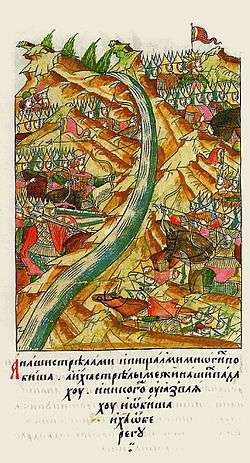
A contemporary of the Tudors and other "new monarchs" in Western Europe, Ivan proclaimed his absolute sovereignty over all Russian princes and nobles. Refusing further tribute to the Tatars, Ivan initiated a series of attacks that opened the way for the complete defeat of the declining Golden Horde, now divided into several Khanates and hordes. Ivan and his successors sought to protect the southern boundaries of their domain against attacks of the Crimean Tatars and other hordes.[52] To achieve this aim, they sponsored the construction of the Great Abatis Belt and granted manors to nobles, who were obliged to serve in the military. The manor system provided a basis for an emerging cavalry based army.
In this way, internal consolidation accompanied outward expansion of the state. By the 16th century, the rulers of Moscow considered the entire Russian territory their collective property. Various semi-independent princes still claimed specific territories,[49] but Ivan III forced the lesser princes to acknowledge the grand prince of Moscow and his descendants as unquestioned rulers with control over military, judicial, and foreign affairs. Gradually, the Russian ruler emerged as a powerful, autocratic ruler, a tsar. The first Russian ruler to officially crown himself "Tsar" was Ivan IV.[44]
Ivan III tripled the territory of his state, ended the dominance of the Golden Horde over the Rus', renovated the Moscow Kremlin, and laid the foundations of the Russian state. Biographer Fennell concludes that his reign was "militarily glorious and economically sound," and especially points to his territorial annexations and his centralized control over local rulers. However, Fennell, the leading British specialist on Ivan III, argues that his reign was also "a period of cultural depression and spiritual barrenness. Freedom was stamped out within the Russian lands. By his bigoted anti-Catholicism Ivan brought down the curtain between Russia and the west. For the sake of territorial aggrandizement he deprived his country of the fruits of Western learning and civilization."[53]
Tsardom of Russia (1547–1721)
Ivan IV, the Terrible

The development of the Tsar's autocratic powers reached a peak during the reign of Ivan IV (1547–1584), known as "Ivan the Terrible".[54][55] He strengthened the position of the monarch to an unprecedented degree, as he ruthlessly subordinated the nobles to his will, exiling or executing many on the slightest provocation.[44] Nevertheless, Ivan is often seen as a farsighted statesman who reformed Russia as he promulgated a new code of laws (Sudebnik of 1550),[56] established the first Russian feudal representative body (Zemsky Sobor), curbed the influence of the clergy,[57] and introduced local self-management in rural regions.[58]
Although his long Livonian War for control of the Baltic coast and access to the sea trade ultimately proved a costly failure,[59] Ivan managed to annex the Khanates of Kazan, Astrakhan, and Siberia.[60] These conquests complicated the migration of aggressive nomadic hordes from Asia to Europe via the Volga and Urals. Through these conquests, Russia acquired a significant Muslim Tatar population and emerged as a multiethnic and multiconfessional state. Also around this period, the mercantile Stroganov family established a firm foothold in the Urals and recruited Russian Cossacks to colonise Siberia.[61]
In the later part of his reign, Ivan divided his realm in two. In the zone known as the oprichnina, Ivan's followers carried out a series of bloody purges of the feudal aristocracy (whom he suspected of treachery after the betrayal of prince Kurbsky), culminating in the Massacre of Novgorod in 1570. This combined with the military losses, epidemics, and poor harvests so weakened Russia that the Crimean Tatars were able to sack central Russian regions and burn down Moscow in 1571.[62] In 1572 Ivan abandoned the oprichnina.[63][64]
At the end of Ivan IV's reign the Polish–Lithuanian and Swedish armies carried out a powerful intervention in Russia, devastating its northern and northwest regions.[65]
Time of Troubles

The death of Ivan's childless son Feodor was followed by a period of civil wars and foreign intervention known as the "Time of Troubles" (1606–13).[44] Extremely cold summers (1601–1603) wrecked crops,[66] which led to the Russian famine of 1601–1603 and increased the social disorganization. Boris Godunov's (Борис Годунов) reign ended in chaos, civil war combined with foreign intrusion, devastation of many cities and depopulation of the rural regions. The country rocked by internal chaos also attracted several waves of interventions by the Polish–Lithuanian Commonwealth.[67]
During the Polish–Muscovite War (1605–1618), Polish–Lithuanian forces reached Moscow and installed the impostor False Dmitriy I in 1605, then supported False Dmitry II in 1607. The decisive moment came when a combined Russian-Swedish army was routed by the Polish forces under hetman Stanisław Żółkiewski at the Battle of Klushino on 4 July [O.S. 24 June] 1610. As the result of the battle, the Seven Boyars, a group of Russian nobles, deposed the tsar Vasily Shuysky on 27 July [O.S. 17 July] 1610, and recognized the Polish prince Władysław IV Vasa as the Tsar of Russia on 6 September [O.S. 27 August] 1610.[68][69] The Poles entered Moscow on 21 September [O.S. 11 September] 1610. Moscow revolted but riots there were brutally suppressed and the city was set on fire.[70][71][72]
The crisis provoked a patriotic national uprising against the invasion, both in 1611 and 1612. Finally, a volunteer army, led by the merchant Kuzma Minin and prince Dmitry Pozharsky, expelled the foreign forces from the capital on 4 November [O.S. 22 October] 1612.[73][74][75]
The Russian statehood survived the "Time of Troubles" and the rule of weak or corrupt Tsars because of the strength of the government's central bureaucracy. Government functionaries continued to serve, regardless of the ruler's legitimacy or the faction controlling the throne.[44] However, the "Time of Troubles" provoked by the dynastic crisis resulted in the loss of much territory to the Polish–Lithuanian Commonwealth in the Russo-Polish war, as well as to the Swedish Empire in the Ingrian War.
Accession of the Romanovs and early rule
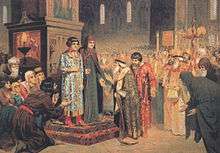
In February 1613, with the chaos ended and the Poles expelled from Moscow, a national assembly, composed of representatives from fifty cities and even some peasants, elected Michael Romanov, the young son of Patriarch Filaret, to the throne. The Romanov dynasty ruled Russia until 1917.
The immediate task of the new dynasty was to restore peace. Fortunately for Moscow, its major enemies, the Polish–Lithuanian Commonwealth and Sweden, were engaged in a bitter conflict with each other, which provided Russia the opportunity to make peace with Sweden in 1617 and to sign a truce with the Polish–Lithuanian Commonwealth in 1619.
Recovery of lost territories began in the mid-17th century, when the Khmelnitsky Uprising (1648–57) in Ukraine against Polish rule brought about the Treaty of Pereyaslav, concluded between Russia and the Ukrainian Cossacks. According to the treaty, Russia granted protection to the Cossacks state in Left-bank Ukraine, formerly under Polish control. This triggered a prolonged Russo-Polish War (1654-1667), which ended with the Treaty of Andrusovo, where Poland accepted the loss of Left-bank Ukraine, Kiev and Smolensk.[44]
Rather than risk their estates in more civil war, the boyars cooperated with the first Romanovs, enabling them to finish the work of bureaucratic centralization. Thus, the state required service from both the old and the new nobility, primarily in the military. In return, the tsars allowed the boyars to complete the process of enserfing the peasants.

In the preceding century, the state had gradually curtailed peasants' rights to move from one landlord to another. With the state now fully sanctioning serfdom, runaway peasants became state fugitives, and the power of the landlords over the peasants "attached" to their land had become almost complete. Together the state and the nobles placed an overwhelming burden of taxation on the peasants, whose rate was 100 times greater in the mid-17th century than it had been a century earlier. In addition, middle-class urban tradesmen and craftsmen were assessed taxes, and, like the serfs, they were forbidden to change residence. All segments of the population were subject to military levy and to special taxes.[76]
Riots amongst peasants and citizens of Moscow at this time were endemic, and included the Salt Riot (1648),[77] Copper Riot (1662),[77] and the Moscow Uprising (1682).[78] By far the greatest peasant uprising in 17th-century Europe erupted in 1667. As the free settlers of South Russia, the Cossacks, reacted against the growing centralization of the state, serfs escaped from their landlords and joined the rebels. The Cossack leader Stenka Razin led his followers up the Volga River, inciting peasant uprisings and replacing local governments with Cossack rule.[44] The tsar's army finally crushed his forces in 1670; a year later Stenka was captured and beheaded. Yet, less than half a century later, the strains of military expeditions produced another revolt in Astrakhan, ultimately subdued.
Russian Empire (1721–1917)
Population
Much of Russia's expansion occurred in the 17th century, culminating in the first Russian colonisation of the Pacific in the mid-17th century, the Russo-Polish War (1654–67) that incorporated left-bank Ukraine, and the Russian conquest of Siberia. Poland was divided in the 1790–1815 era, with much of the land and population going to Russia. Most of the 19th century growth came from adding territory in Asia, south of Siberia.[79]
| Year | Population of Russia (millions) | Notes |
| 1720 | 15.5 | includes new Baltic & Polish territories |
| 1795 | 37.6 | includes part of Poland |
| 1812 | 42.8 | includes Finland |
| 1816 | 73.0 | includes Congress Poland, Bessarabia |
| 1914 | 170.0 | includes new Asian territories |
| source: Brian Catchpole, A Map History of Russia (1974) p 25. |
Peter the Great
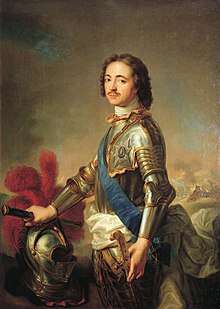
Peter the Great (1672–1725) brought centralized autocracy into Russia and played a major role in bringing his country into the European state system.[80] Russia had now become the largest country in the world, stretching from the Baltic Sea to the Pacific Ocean. The vast majority of the land was unoccupied, and travel was slow. Much of its expansion had taken place in the 17th century, culminating in the first Russian settlement of the Pacific in the mid-17th century, the reconquest of Kiev, and the pacification of the Siberian tribes.[81] However, a population of only 14 million was stretched across this vast landscape. With a short growing season grain yields trailed behind those in the West and potato farming was not yet widespread. As a result, the great majority of the population workforce was occupied with agriculture. Russia remained isolated from the sea trade and its internal trade, communication and manufacturing were seasonally dependent.[82]

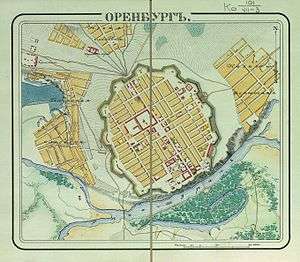
Peter's first military efforts were directed against the Ottoman Turks. His aim was to establish a Russian foothold on the Black Sea by taking the town of Azov.[83] His attention then turned to the north. Peter still lacked a secure northern seaport except at Archangel on the White Sea, whose harbor was frozen nine months a year. Access to the Baltic was blocked by Sweden, whose territory enclosed it on three sides. Peter's ambitions for a "window to the sea" led him in 1699 to make a secret alliance with the Polish–Lithuanian Commonwealth and Denmark against Sweden resulting in the Great Northern War.
The war ended in 1721 when an exhausted Sweden sued for peace with Russia. Peter acquired four provinces situated south and east of the Gulf of Finland, thus securing his coveted access to the sea. There, in 1703, he had already founded the city that was to become Russia's new capital, Saint Petersburg, as a "window opened upon Europe" to replace Moscow, long Russia's cultural center. Russian intervention in the Commonwealth marked, with the Silent Sejm, the beginning of a 200-year domination of that region by the Russian Empire. In celebration of his conquests, Peter assumed the title of emperor, and the Russian Tsardom officially became the Russian Empire in 1721.

Peter reorganized his government based on the latest Western models, molding Russia into an absolutist state. He replaced the old boyar Duma (council of nobles) with a nine-member senate, in effect a supreme council of state. The countryside was also divided into new provinces and districts. Peter told the senate that its mission was to collect tax revenues. In turn tax revenues tripled over the course of his reign.[84]
Administrative Collegia (ministries) were established in St. Petersburg, to replace the old governmental departments. In 1722 Peter promulgated his famous Table of ranks. As part of the government reform, the Orthodox Church was partially incorporated into the country's administrative structure, in effect making it a tool of the state. Peter abolished the patriarchate and replaced it with a collective body, the Holy Synod, led by a lay government official. Peter continued and intensified his predecessors' requirement of state service for all nobles.
By this same time, the once powerful Persian Safavid Empire to the south was heavily declining. Taking advantage of the profitable situation, Peter launched the Russo-Persian War (1722-1723), known as "The Persian Expedition of Peter the Great" by Russian histographers, in order to be the first Russian emperor to establish Russian influence in the Caucasus and Caspian Sea region. After considerable success and the capture of many provinces and cities in the Caucasus and northern mainland Persia, the Safavids were forced to hand over the territories to Russia. However, by twelve years later, all the territories were ceded back to Persia, which was now led by the charismatic military genius Nader Shah, as part of the Treaty of Resht and Treaty of Ganja and the Russo-Persian alliance against the Ottoman Empire,[85] the common neighbouring rivalling enemy.
Peter the Great died in 1725, leaving an unsettled succession, but Russia had become a great power by the end of his reign. Peter I was succeeded by his second wife, Catherine I (1725–1727), who was merely a figurehead for a powerful group of high officials, then by his minor grandson, Peter II (1727–1730), then by his niece, Anna (1730–1740), daughter of Tsar Ivan V. The heir to Anna was soon deposed in a coup and Elizabeth, daughter of Peter I, ruled from 1741 to 1762. During her reign, Russia took part in the Seven Years' War.
Catherine the Great
Nearly forty years were to pass before a comparably ambitious ruler appeared on the Russian throne. Catherine II, "the Great" (r. 1762–1796), was a German princess who married the German heir to the Russian crown. He took weak positions, and Catherine overthrew him in a coup in 1762, becoming queen regnant.[86][87] Catherine enthusiastically supported the ideals of The Enlightenment, thus earning the status of an enlightened despot[88] She patronized the arts, science and learning. She contributed to the resurgence of the Russian nobility that began after the death of Peter the Great. Catherine promulgated the Charter to the Gentry reaffirming rights and freedoms of the Russian nobility and abolishing mandatory state service. She seized control of all the church lands, drastically reduced the size of the monasteries, and put the surviving clergy on a tight budget.[89]
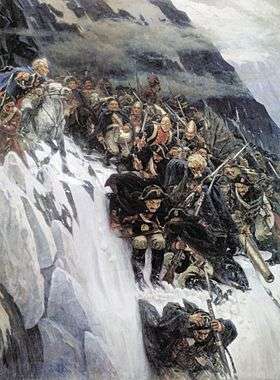
Catherine spent heavily to promote an expansive foreign policy. She extended Russian political control over the Polish–Lithuanian Commonwealth with actions, including the support of the Targowica Confederation. The cost of her campaigns, on top of the oppressive social system that required serfs to spend almost all of their time laboring on the land of their lords, provoked a major peasant uprising in 1773. Inspired by a Cossack named Pugachev, with the emphatic cry of "Hang all the landlords!", the rebels threatened to take Moscow until Catherine crushed the rebellion. Like the other enlightened despots of Europe, Catherine made certain of her own power and formed an alliance with the nobility.[90]
Catherine successfully waged war against the decaying Ottoman Empire[91] and advanced Russia's southern boundary to the Black Sea. Then, by allying with the rulers of Austria and Prussia, she incorporated the territories of the Polish–Lithuanian Commonwealth, where after a century of Russian rule non-Catholic, mainly Orthodox population prevailed[92] during the Partitions of Poland, pushing the Russian frontier westward into Central Europe.[93]
In accordance to the treaty Russia had signed with the Georgians to protect them against any new invasion of their Persian suzerains and further political aspirations, Catherine waged a new war against Persia in 1796 after they had again invaded Georgia and established rule over it about a year prior, and had expelled the newly established Russian garrisons in the Caucasus.
Ruling the Empire (1725–1825)
Innovative tsars such as Peter the Great and Catherine the Great brought in Western experts, scientists, philosophers, and engineers. Powerful Russians resented their privileged positions and alien ideas. The backlash was especially severe after the Napoleonic wars. It produced a powerful anti-western campaign that "led to a wholesale purge of Western specialists and their Russian followers in universities, schools, and government service."[94]
State budget

Russia was in a continuous state of financial crisis. While revenue rose from 9 million rubles in 1724 to 40 million in 1794, expenses grew more rapidly, reaching 49 million in 1794. The budget was allocated 46 percent to the military, 20 percent to government economic activities, 12 percent to administration, and nine percent for the Imperial Court in St. Petersburg. The deficit required borrowing, primarily from Amsterdam; five percent of the budget was allocated to debt payments. Paper money was issued to pay for expensive wars, thus causing inflation. For its spending, Russia obtained a large and glorious army, a very large and complex bureaucracy, and a splendid court that rivaled Paris and London. However, the government was living far beyond its means, and 18th-century Russia remained "a poor, backward, overwhelmingly agricultural, and illiterate country."[95]
Alexander I
By the time of her death in 1796, Catherine's expansionist policy had made Russia into a major European power. Alexander I continued this policy, wresting Finland from the weakened kingdom of Sweden in 1809 and Bessarabia from the Ottomans in 1812.
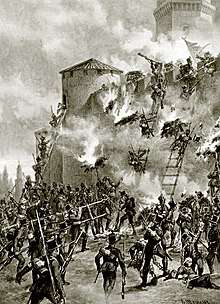
After Russian armies liberated allied Georgia from Persian occupation in 1802, they clashed with Persia over control and consolidation over Georgia, as well as the Iranian territories that comprise modern-day Azerbaijan and Dagestan. They also became involved in the Caucasian War against the Caucasian Imamate. In 1813, the war with Persia concluded with a Russian victory, forcing Qajar Iran to cede swaths of its territories in the Caucasus to Russia,[96] which drastically increased its territory in the region. To the south-west, Russia attempted to expand at the expense of the Ottoman Empire, using Georgia at its base for the Caucasus and Anatolian front.
In European policy, Alexander I switched Russia back and forth four times in 1804–1812 from neutral peacemaker to anti-Napoleon to an ally of Napoleon, winding up in 1812 as Napoleon's enemy. In 1805, he joined Britain in the War of the Third Coalition against Napoleon, but after the massive defeat at the Battle of Austerlitz he switched and formed an alliance with Napoleon by the Treaty of Tilsit (1807) and joined Napoleon's Continental System. He fought a small-scale naval war against Britain, 1807–12. He and Napoleon could never agree, especially about Poland, and the alliance collapsed by 1810.
Furthermore, Russia's economy had been hurt by Napoleon's Continental System, which cut off trade with Britain. As Esdaile notes, "Implicit in the idea of a Russian Poland was, of course, a war against Napoleon."[97] Schroeder says Poland was the root cause of the conflict but Russia's refusal to support the Continental System was also a factor.[98]


The invasion of Russia was a catastrophe for Napoleon and his 450,000 invasion troops. One major battle was fought at Borodino; casualties were very high but it was indecisive and Napoleon was unable to engage and defeat the Russian armies. He attempted to force the Tsar to terms by capturing Moscow at the onset of winter, even though the French Army had already lost most of its men. The expectation proved futile. The Russians retreated, burning crops and food supplies in a scorched earth policy that multiplied Napoleon's logistic problems. Unprepared for winter warfare, 85%–90% of Napoleon's soldiers died from disease, cold, starvation or by ambush by peasant guerrilla fighters. As Napoleon's forces retreated, Russian troops pursued them into Central and Western Europe and finally captured Paris.[99][100] Out of a total population of around 43 million people,[101] Russia lost about 1.5 million in the year 1812; of these about 250,000 to 300,000 were soldiers and the rest peasants and serfs.[102]
After the final defeat of Napoleon in 1815, Alexander became known as the 'savior of Europe.' He presided over the redrawing of the map of Europe at the Congress of Vienna (1814–15), which made him the king of Congress Poland. He formed the Holy Alliance with Austria and Prussia, to suppress revolutionary movements in Europe that he saw as immoral threats to legitimate Christian monarchs. He helped Austria's Klemens von Metternich in suppressing all national and liberal movements.
Although the Russian Empire would play a leading political role as late as 1848, its retention of serfdom precluded economic progress of any significant degree. As West European economic growth accelerated during the Industrial Revolution, sea trade and colonialism which had begun in the second half of the 18th century, Russia began to lag ever farther behind, undermining its ability to field strong armies.
Nicholas I and the Decembrist Revolt
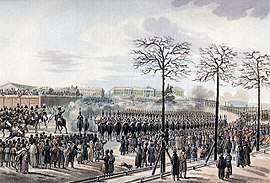
Russia's great power status obscured the inefficiency of its government, the isolation of its people, and its economic backwardness.[103] Following the defeat of Napoleon, Alexander I was willing to discuss constitutional reforms, and though a few were introduced, no thoroughgoing changes were attempted.[104]
The tsar was succeeded by his younger brother, Nicholas I (1825–1855), who at the onset of his reign was confronted with an uprising. The background of this revolt lay in the Napoleonic Wars, when a number of well-educated Russian officers traveled in Europe in the course of the military campaigns, where their exposure to the liberalism of Western Europe encouraged them to seek change on their return to autocratic Russia. The result was the Decembrist Revolt (December 1825), the work of a small circle of liberal nobles and army officers who wanted to install Nicholas' brother as a constitutional monarch. But the revolt was easily crushed, leading Nicholas to turn away from liberal reforms and champion the reactionary doctrine "Orthodoxy, Autocracy, and Nationality".[105]
In 1826–1828 Russia fought another war against Persia. Russia lost almost all of its recently consolidated territories during the first year but gained them back and won the war on highly favourable terms. At the 1828 Treaty of Turkmenchay, Russia gained Armenia, Nakhchivan, Nagorno-Karabakh, Azerbaijan, and Iğdır.[106] In the 1828–1829 Russo-Turkish War Russia invaded northeastern Anatolia and occupied the strategic Ottoman towns of Erzurum and Gumushane and, posing as protector and saviour of the Greek Orthodox population, received extensive support from the region's Pontic Greeks. Following a brief occupation, the Russian imperial army withdrew back into Georgia. By the 1830s, Russia had conquered all Persian territories and major Ottoman territories in the Caucasus.[107]
In 1831 Nicholas crushed the November Uprising in Poland. The Russian autocracy gave Polish artisans and gentry reason to rebel in 1863 by assailing the national core values of language, religion, and culture.[108] The resulting January Uprising was a massive Polish revolt, which also was crushed. France, Britain and Austria tried to intervene in the crisis but were unable to do so. The Russian patriotic press used the Polish uprising to unify the Russian nation, claiming it was Russia's God-given mission to save Poland and the world.[109] Poland was punished by losing its distinctive political and judicial rights, with Russianization imposed on its schools and courts.[110]
Russian Army
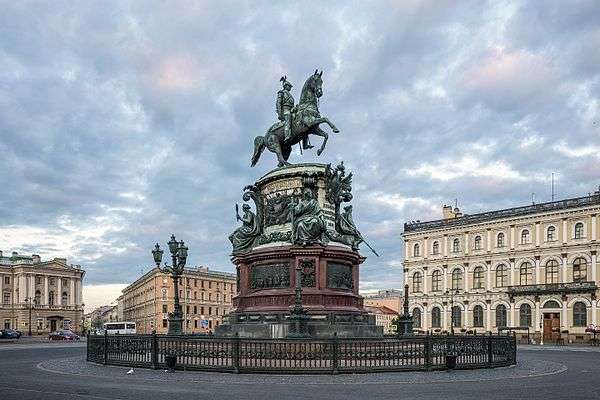
Tsar Nicholas I (reigned 1825–1855) lavished attention on his very large army; with a population of 60–70 million people, the army included a million men. They had outdated equipment and tactics, but the tsar, who dressed like a soldier and surrounded himself with officers, gloried in the victory over Napoleon in 1812 and took enormous pride in its smartness on parade. The cavalry horses, for example, were only trained in parade formations, and did poorly in battle. The glitter and braid masked profound weaknesses that he did not see. He put generals in charge of most of his civilian agencies regardless of their qualifications. An agnostic who won fame in cavalry charges was made supervisor of Church affairs. The Army became the vehicle of upward social mobility for noble youths from non-Russian areas, such as Poland, the Baltic, Finland and Georgia. On the other hand, many miscreants, petty criminals and undesirables were punished by local officials by enlisting them for life in the Army. The conscription system was highly unpopular with people, as was the practice of forcing peasants to house the soldiers for six months of the year. Curtiss finds that "The pedantry of Nicholas' military system, which stressed unthinking obedience and parade ground evolutions rather than combat training, produced ineffective commanders in time of war." His commanders in the Crimean War were old and incompetent, and indeed so were his muskets as the colonels sold the best equipment and the best food.[111]
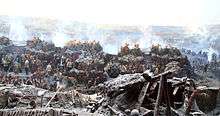
Finally the Crimean War at the end of his reign demonstrated to the world what no one had previously realized: Russia was militarily weak, technologically backward, and administratively incompetent. Despite his grand ambitions toward the south and Ottoman Empire, Russia had not built its railroad network in that direction, and communications were bad. The bureaucracy was riddled with graft, corruption and inefficiency and was unprepared for war. The Navy was weak and technologically backward; the Army, although very large, was good only for parades, suffered from colonels who pocketed their men's pay, poor morale, and was even more out of touch with the latest technology as developed by Britain and France. As Fuller notes, "Russia had been beaten on the Crimean peninsula, and the military feared that it would inevitably be beaten again unless steps were taken to surmount its military weakness."[112][113][114]
Slavophiles and Westernizers
As Western Europe modernized, after 1840 the issue for Russia became one of direction. Westernizers favored imitating Western Europe while others renounced the West and called for a return of the traditions of the past. The latter path was championed by Slavophiles, who heaped scorn on the "decadent" West. The Slavophiles were opponents of bureaucracy and preferred the collectivism of the medieval Russian mir, or village community, to the individualism of the West.[115]
Westernizers
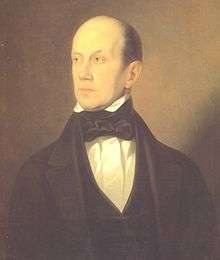
Westernizers formed an intellectual movement that deplored the backwardness of Russian culture, and looked to western Europe for intellectual leadership. They were opposed by Slavophiles who denounced the West as too materialistic and instead promoted the spiritual depth of Russian traditionalism.[116] A forerunner of the movement was Pyotr Chaadayev (1794–1856). He exposed the cultural isolation of Russia, from the perspective of Western Europe, in his Philosophical Letters of 1831. He cast doubt on the greatness of the Russian past, and ridiculed Orthodoxy for failing to provide a sound spiritual basis for the Russian mind. He called on Russia to emulate Western Europe, especially in rational and logical thought, its progressive spirit, its leadership in science, and indeed its leadership on the path to freedom.[117][118] Vissarion Belinsky (1811–1848),[119] and Alexander Herzen (1812–1870) were prominent Westernizers.[120]
The Crimean War
Since the war against Napoleon, Russia had become deeply involved in the affairs of Europe, as part of the "Holy Alliance." The Holy Alliance was formed to serve as the "policeman of Europe." However, to be the policeman of Europe and maintain the alliance required large armies. Prussia, Austria, Britain and France (the other members of the alliance) lacked large armies and needed Russia to supply the required numbers, which fit the philosophy of Nicholas I. When the Revolutions of 1848 swept Europe, however, Russia was quiet. The Tsar sent his army into Hungary in 1849 at the request of the Austrian Empire and broke the revolt there, while preventing its spread to Russian Poland. The Tsar cracked down on any signs of internal unrest.[121]
Russia expected that in exchange for supplying the troops to be the policeman of Europe, it should have a free hand in dealing with the decaying Ottoman Empire—the "sick man of Europe." In 1853 Russia invaded Ottoman-controlled areas leading to the Crimean War. Britain and France came to the rescue of the Ottomans. After a gruelling war fought largely in Crimea, with very high death rates from disease, the allies won.[122][123]
Historian Orlando Figes points to the long-term damage Russia suffered:
- The demilitarization of the Black Sea was a major blow to Russia, which was no longer able to protect its vulnerable southern coastal frontier against the British or any other fleet.... The destruction of the Russian Black Sea Fleet, Sevastopol and other naval docks was a humiliation. No compulsory disarmament had ever been imposed on a great power previously.... The Allies did not really think that they were dealing with a European power in Russia. They regarded Russia as a semi-Asiatic state....In Russia itself, the Crimean defeat discredited the armed services and highlighted the need to modernize the countries defences, not just in the strictly military sense, but also through the building of railways, industrialization, sound finances and so on....The image many Russians had built up of their country – the biggest, richest and most powerful in the world – had suddenly been shattered. Russia's backwardness had been exposed....The Crimean disaster had exposed the shortcomings of every institution in Russia – not just the corruption and incompetence of the military command, the technological backwardness of the army and navy, or the inadequate roads and lack of railways the accounted for the chronic problems of supply, but the poor condition and illiteracy of the serfs who made up the armed forces, the inability of the serf economy to sustain a state of war against industrial powers, and the failures of autocracy itself.[124]
As Fuller notes, "Russia had been beaten on the Crimean peninsula, and the military feared that it would inevitably be beaten again unless steps were taken to surmount its military weakness."[125]
Alexander II and the abolition of serfdom
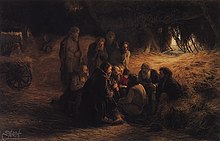
Tsar Nicholas died with his philosophy in dispute. One year earlier, Russia had become involved in the Crimean War, a conflict fought primarily in the Crimean peninsula.[126] Since playing a major role in the defeat of Napoleon, Russia had been regarded as militarily invincible, but, once pitted against a coalition of the great powers of Europe, the reverses it suffered on land and sea exposed the weakness of Tsar Nicholas' regime.
When Alexander II came to the throne in 1855, desire for reform was widespread. The most pressing problem confronting the Government was serfdom. In 1859, there were 23 million serfs (out of a total population of 67.1 Million).[127] In anticipation of civil unrest that could ultimately foment a revolution, Alexander II chose to preemptively abolish serfdom with the emancipation reform in 1861. Emancipation brought a supply of free labor to the cities, stimulated industry, and the middle class grew in number and influence. The freed peasants had to buy land, allotted to them, from the landowners with the state assistance. The Government issued special bonds to the landowners for the land that they had lost, and collected a special tax from the peasants, called redemption payments, at a rate of 5% of the total cost of allotted land yearly. All the land turned over to the peasants was owned collectively by the mir, the village community, which divided the land among the peasants and supervised the various holdings.[128][129]
Alexander was the most successful Russian reformer since Peter the Great, and was responsible for numerous reforms besides abolishing serfdom. He reorganized the judicial system, setting up elected local judges, abolishing capital punishment, promoting local self-government through the zemstvo system, imposing universal military service, ending some of the privileges of the nobility, and promoting the universities. In foreign policy, he sold Alaska to the United States in 1867, fearing the remote colony would fall into British hands if there was another war. He modernized the military command system. He sought peace, and moved away from bellicose France when Napoleon III fell. He joined with Germany and Austria in the League of the Three Emperors that stabilized the European situation. The Russian Empire expanded in Siberia and in the Caucasus and made gains at the expense of China. Faced with an uprising in Poland in 1863, he stripped that land of its separate Constitution and incorporated it directly into Russia. To counter the rise of a revolutionary and anarchistic movements, he sent thousands of dissidents into exile in Siberia and was proposing additional parliamentary reforms when he was assassinated in 1881.[130]
In the late 1870s Russia and the Ottoman Empire again clashed in the Balkans. The Russo-Turkish War was popular among the Russian people, who supported the independence of their fellow Orthodox Slavs, the Serbs and the Bulgarians. However, the war increased tension with Austria-Hungary, which also had ambitions in the region. The tsar was disappointed by the results of the Congress of Berlin in 1878, but abided by the agreement.[131] During this period Russia expanded its empire into Central Asia, which was rich in raw materials, conquering the khanates of Kokand, Bokhara, and Khiva, as well as the Trans-Caspian region.[132]
Nihilist movement
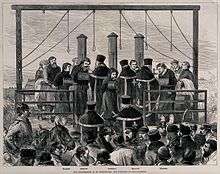
In the 1860s a movement known as Nihilism developed in Russia. A term originally coined by Ivan Turgenev in his 1862 novel Fathers and Sons, Nihilists favoured the destruction of human institutions and laws, based on the assumption that such institutions and laws are artificial and corrupt. At its core, Russian nihilism was characterized by the belief that the world lacks comprehensible meaning, objective truth, or value. For some time many Russian liberals had been dissatisfied by what they regarded as the empty discussions of the intelligentsia. The Nihilists questioned all old values and shocked the Russian establishment.[133] They moved beyond being purely philosophical to becoming major political forces after becoming involved in the cause of reform. Their path was facilitated by the previous actions of the Decembrists, who revolted in 1825, and the financial and political hardship caused by the Crimean War, which caused many Russians to lose faith in political institutions.[134]
The Nihilists first attempted to convert the aristocracy to the cause of reform. Failing there, they turned to the peasants.[135] Their campaign, which targeted the people instead of the aristocracy or the landed gentry, became known as the Populist movement. It was based upon the belief that the common people possessed the wisdom and peaceful ability to lead the nation.[136]
While the Narodnik movement was gaining momentum, the government quickly moved to extirpate it. In response to the growing reaction of the government, a radical branch of the Narodniks advocated and practiced terrorism.[136] One after another, prominent officials were shot or killed by bombs. This represented the ascendancy of anarchism in Russia as a powerful revolutionary force. Finally, after several attempts, Alexander II was assassinated by anarchists in 1881, on the very day he had approved a proposal to call a representative assembly to consider new reforms in addition to the abolition of serfdom designed to ameliorate revolutionary demands.[137]
Autocracy and reaction under Alexander III
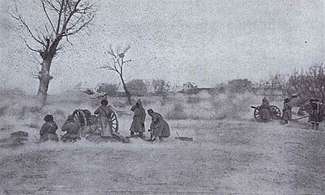
Unlike his father, the new tsar Alexander III (1881–1894) was throughout his reign a staunch reactionary who revived the maxim of "Orthodoxy, Autocracy, and National Character".[138] A committed Slavophile, Alexander III believed that Russia could be saved from chaos only by shutting itself off from the subversive influences of Western Europe. In his reign Russia concluded the union with republican France to contain the growing power of Germany, completed the conquest of Central Asia, and exacted important territorial and commercial concessions from China.
The tsar's most influential adviser was Konstantin Pobedonostsev, tutor to Alexander III and his son Nicholas, and procurator of the Holy Synod from 1880 to 1895. He taught his royal pupils to fear freedom of speech and press and to hate democracy, constitutions, and the parliamentary system.[139] Under Pobedonostsev, revolutionaries were hunted down[140] and a policy of Russification was carried out throughout the empire.[141]
Nicholas II and new revolutionary movement
Alexander was succeeded by his son Nicholas II (1894–1917). The Industrial Revolution, which began to exert a significant influence in Russia, was meanwhile creating forces that would finally overthrow the tsar. Politically, these opposition forces organized into three competing parties: The liberal elements among the industrial capitalists and nobility, who believed in peaceful social reform and a constitutional monarchy, founded the Constitutional Democratic party or Kadets in 1905. Followers of the Narodnik tradition established the Socialist-Revolutionary Party or Esers in 1901, advocating the distribution of land among those who actually worked it—the peasants. A third radical group founded the Russian Social Democratic Labour Party or RSDLP in 1898; this party was the primary exponent of Marxism in Russia. Gathering their support from the radical intellectuals and the urban working class, they advocated complete social, economic and political revolution.[142]
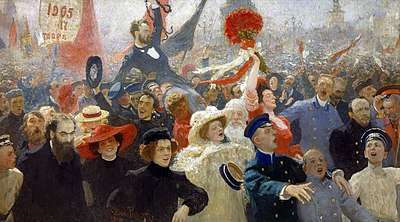
In 1903 the RSDLP split into two wings: the radical Bolsheviks, led by Vladimir Lenin, and the relatively moderate Mensheviks, led by Yuli Martov. The Mensheviks believed that Russian socialism would grow gradually and peacefully and that the tsar's regime should be succeeded by a democratic republic in which the socialists would cooperate with the liberal bourgeois parties. The Bolsheviks advocated the formation of a small elite of professional revolutionists, subject to strong party discipline, to act as the vanguard of the proletariat in order to seize power by force.[143]
Revolution of 1905
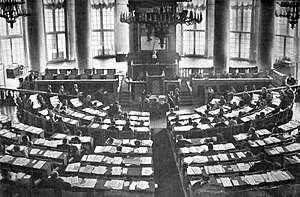
The disastrous performance of the Russian armed forces in the Russo-Japanese War was a major blow to the Russian State and increased the potential for unrest.[144]
In January 1905, an incident known as "Bloody Sunday" occurred when Father Gapon led an enormous crowd to the Winter Palace in Saint Petersburg to present a petition to the tsar. When the procession reached the palace, Cossacks opened fire on the crowd, killing hundreds.[144] The Russian masses were so aroused over the massacre that a general strike was declared demanding a democratic republic. This marked the beginning of the Russian Revolution of 1905. Soviets (councils of workers) appeared in most cities to direct revolutionary activity.[145]
In October 1905, Nicholas reluctantly issued the October Manifesto, which conceded the creation of a national Duma (legislature) to be called without delay.[144] The right to vote was extended, and no law was to go into force without confirmation by the Duma. The moderate groups were satisfied;[144] but the socialists rejected the concessions as insufficient and tried to organize new strikes. By the end of 1905, there was disunity among the reformers, and the tsar's position was strengthened for the time being.[146]
Russian avant-garde
The Russian avant-garde was a large, influential wave of modern art that flourished in Russian Empire and Soviet Union, approximately from 1890 to 1930—although some have placed its beginning as early as 1850 and its end as late as 1960. The term covers many separate art movements of the era in painting, literature, music and architecture.
World War I
The Archduke Franz Ferdinand of Austro-Hungary was assassinated by Bosnian Serbs on 28 June 1914. An ultimatum followed to Serbia, which was considered a Russian client-state, by Austro-Hungary on 23 July. Russia had no treaty obligation to Serbia, and in long-term perspective, Russia was militarily gaining on Germany and Austro-Hungary, and thus had an incentive to wait. Most Russian leaders wanted to avoid a war. However, in the present crisis they had the support of France, and they feared that the failure to support Serbia would lead to a loss of Russian credibility and a major political defeat to Russia's goals for a leadership role in the Balkans.[147] Tsar Nicholas II mobilised Russian forces on 30 July 1914 to defend Serbia from Austria-Hungary. Christopher Clark states: "The Russian general mobilisation [of 30 July] was one of the most momentous decisions of the July crisis. This was the first of the general mobilisations. It came at the moment when the German government had not yet even declared the State of Impending War".[148] Germany responded with her own mobilisation and declaration of War on 1 August 1914. At the opening of hostilities, the Russians took the offensive against both Germany and Austria-Hungary.[149]
The very large but poorly equipped Russian army fought tenaciously and desperately at times despite its lack of organization and very weak logistics. Casualties were enormous. By 1915, many soldiers were sent to the front unarmed, and told to pick up whatever weapons they could from the battlefield. Nevertheless, the Russian army fought on, and tied down large numbers of Germans and Austrians. When civilians showed a surge of patriotism, the tsar and his entourage failed to exploit it for military benefit. Instead, they relied on slow-moving bureaucracies. In areas where they did advance against the Austrians, they failed to rally the ethnic and religious minorities that were hostile to Austria, such as Poles. The tsar refused to cooperate with the national legislature, the Duma, and listened less to experts than to his wife, who was in thrall to her chief advisor, the so-called holy man Grigori Rasputin.[150] More than two million refugees fled.[151]
Repeated military failures and bureaucratic ineptitude soon turned large segments of the population against the government.[144] The German and Ottoman fleets prevented Russia from importing supplies and exporting goods through the Baltic and Black seas.[144]
By the middle of 1915 the impact of the war was demoralizing. Food and fuel were in short supply, casualties kept occurring, and inflation was mounting. Strikes increased among low-paid factory workers, and the peasants, who wanted land reforms, were restless.[152] Meanwhile, elite distrust of the regime was deepened by reports that Rasputin was gaining influence; his assassination in late 1916 ended the scandal but did not restore the autocracy's lost prestige.[144]
Soviet Russia (1917–1922)
Russian Revolution
The Tsarist system was completely overthrown in February 1917. Rabinowitch argues:
The February 1917 revolution...grew out of prewar political and economic instability, technological backwardness, and fundamental social divisions, coupled with gross mismanagement of the war effort, continuing military defeats, domestic economic dislocation, and outrageous scandals surrounding the monarchy.[153]
In late February (3 March 1917), a strike occurred in a factory in the capital Petrograd (the new name for Saint Petersburg). On 23 February (8 March) 1917, thousands of female textile workers walked out of their factories protesting the lack of food and calling on other workers to join them. Within days, nearly all the workers in the city were idle, and street fighting broke out. The tsar ordered the Duma to disband, ordered strikers to return to work, and ordered troops to shoot at demonstrators in the streets. His orders triggered the February Revolution, especially when soldiers openly sided with the strikers. The tsar and the aristocracy fell on 2 March, as Nicholas II abdicated.[154][155]
To fill the vacuum of authority, the Duma declared a Provisional Government, headed by Prince Lvov, which was collectively known as the Russian Republic.[156] Meanwhile, the socialists in Petrograd organized elections among workers and soldiers to form a soviet (council) of workers' and soldiers' deputies, as an organ of popular power that could pressure the "bourgeois" Provisional Government.[156]

In July, following a series of crises that undermined their authority with the public, the head of the Provisional Government resigned and was succeeded by Alexander Kerensky, who was more progressive than his predecessor but not radical enough for the Bolsheviks or many Russians discontented with the deepening economic crisis and the continuation of the war. While Kerensky's government marked time, the socialist-led soviet in Petrograd joined with soviets that formed throughout the country to create a national movement.[157]
The German government provided over 40 million gold marks to subsidize Bolshevik publications and activities subversive of the tsarist government, especially focusing on disgruntled soldiers and workers.[158] In April 1917 Germany provided a special sealed train to carry Vladimir Lenin back to Russia from his exile in Switzerland. After many behind-the-scenes maneuvers, the soviets seized control of the government in November 1917 and drove Kerensky and his moderate provisional government into exile, in the events that would become known as the October Revolution.[159]
When the national Constituent Assembly (elected in December 1917) refused to become a rubber stamp of the Bolsheviks, it was dissolved by Lenin's troops and all vestiges of democracy were removed. With the handicap of the moderate opposition removed, Lenin was able to free his regime from the war problem by the harsh Treaty of Brest-Litovsk (1918) with Germany. Russia lost much of her western borderlands. However, when Germany was defeated the Soviet government repudiated the Treaty.[160]
Russian Civil War


The Bolshevik grip on power was by no means secure, and a lengthy struggle broke out between the new regime and its opponents, which included the Socialist Revolutionaries, right-wing "Whites", and large numbers of peasants. At the same time the Allied powers sent several expeditionary armies to support the anti-Communist forces in an attempt to force Russia to rejoin the world war. The Bolsheviks fought against both these forces and national independence movements in the former Russian Empire. By 1921, they had defeated their internal enemies and brought most of the newly independent states under their control, with the exception of Finland, the Baltic States, the Moldavian Democratic Republic (which joined Romania), and Poland (with whom they had fought the Polish–Soviet War).[161] Finland also annexed the region Pechenga of the Russian Kola peninsula; Soviet Russia and allied Soviet republics conceded the parts of its territory to Estonia (Petseri County and Estonian Ingria), Latvia (Pytalovo), and Turkey (Kars). Poland incorporated the contested territories of Western Belarus and Western Ukraine, the former parts of the Russian Empire (except Galicia) east to Curzon Line.[160]
Both sides regularly committed brutal atrocities against civilians. During the civil war era White Terror (Russia) for example, Petlyura and Denikin's forces massacred 100,000 to 150,000 Jews in Ukraine and southern Russia.[162] Hundreds of thousands of Jews were left homeless and tens of thousands became victims of serious illness.
Estimates for the total number of people killed during the Red Terror carried out by the Bolsheviks vary widely. One source asserts that the total number of victims of repression and pacification campaigns could be 1.3 million,[163] whereas others give estimates ranging from 10,000 in the initial period of repression[164] to 50,000[165] to 140,000[165][166] and an estimate of 28,000 executions per year from December 1917 to February 1922.[167] The most reliable estimations for the total number of killings put the number at about 100,000,[168] whereas others suggest a figure of 200,000.[169]
The Russian economy was devastated by the war, with factories and bridges destroyed, cattle and raw materials pillaged, mines flooded and machines damaged. The droughts of 1920 and 1921, as well as the 1921 famine, worsened the disaster still further. Disease had reached pandemic proportions, with 3,000,000 dying of typhus alone in 1920. Millions more also died of widespread starvation. By 1922 there were at least 7,000,000 street children in Russia as a result of nearly ten years of devastation from the Great War and the civil war.[170] Another one to two million people, known as the White émigrés, fled Russia, many with the White Gen. Pyotr Nikolayevich Wrangel—some through the Far East, others west into the newly independent Baltic countries. These émigrés included a large percentage of the educated and skilled population of Russia.
Soviet Union (1922–1991)
Creation of the Soviet Union
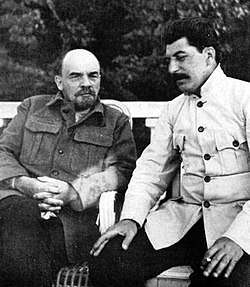
The history of Russia between 1922 and 1991 is essentially the history of the Union of Soviet Socialist Republics, or Soviet Union. This ideologically based union, established in December 1922 by the leaders of the Russian Communist Party,[171] was roughly coterminous with Russia before the Treaty of Brest-Litovsk. At that time, the new nation included four constituent republics: the Russian SFSR, the Ukrainian SSR, the Belarusian SSR, and the Transcaucasian SFSR.[172]
The constitution, adopted in 1924, established a federal system of government based on a succession of soviets set up in villages, factories, and cities in larger regions. This pyramid of soviets in each constituent republic culminated in the All-Union Congress of Soviets. However, while it appeared that the congress exercised sovereign power, this body was actually governed by the Communist Party, which in turn was controlled by the Politburo from Moscow, the capital of the Soviet Union, just as it had been under the tsars before Peter the Great.
War Communism and the New Economic Policy
The period from the consolidation of the Bolshevik Revolution in 1917 until 1921 is known as the period of war communism.[173] Land, all industry, and small businesses were nationalized, and the money economy was restricted. Strong opposition soon developed.[173] The peasants wanted cash payments for their products and resented having to surrender their surplus grain to the government as a part of its civil war policies. Confronted with peasant opposition, Lenin began a strategic retreat from war communism known as the New Economic Policy (NEP).[173] The peasants were freed from wholesale levies of grain and allowed to sell their surplus produce in the open market. Commerce was stimulated by permitting private retail trading. The state continued to be responsible for banking, transportation, heavy industry, and public utilities.
Although the left opposition among the Communists criticized the rich peasants, or kulaks, who benefited from the NEP, the program proved highly beneficial and the economy revived.[173] The NEP would later come under increasing opposition from within the party following Lenin's death in early 1924.[173]
Changes to Russian society
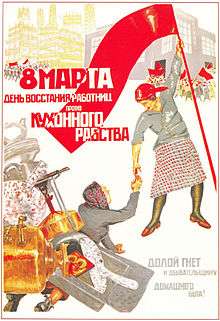
As the Russian Empire included during this period not only the region of Russia, but also today's territories of Ukraine, Belarus, Poland, Lithuania, Estonia, Latvia, Moldavia and the Caucasian and Central Asian countries, it is possible to examine the firm formation process in all those regions. One of the main determinants of firm creation for given regions of Russian Empire might be urban demand of goods and supply of industrial and organizational skill.[174]
While the Russian economy was being transformed, the social life of the people underwent equally drastic changes. The Family Code of 1918 granted women equal status to men, and permitted a couple to take either the husband or wife’s name.[175] Divorce no longer required court procedure,[176] and to make women completely free of the responsibilities of childbearing, abortion was made legal as early as 1920.[177] As a side effect, the emancipation of women increased the labor market. Girls were encouraged to secure an education and pursue a career in the factory or the office. Communal nurseries were set up for the care of small children, and efforts were made to shift the center of people's social life from the home to educational and recreational groups, the soviet clubs.
Industrialization and collectivization
The years from 1929 to 1939 comprised a tumultuous decade in Soviet history—a period of massive industrialization and internal struggles as Joseph Stalin established near total control over Soviet society, wielding virtually unrestrained power. Following Lenin's death Stalin wrestled to gain control of the Soviet Union with rival factions in the Politburo, especially Leon Trotsky's. By 1928, with the Trotskyists either exiled or rendered powerless, Stalin was ready to put a radical programme of industrialisation into action.[178]
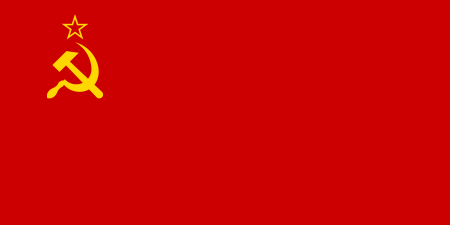
In 1929 Stalin proposed the first five-year plan.[173] Abolishing the NEP, it was the first of a number of plans aimed at swift accumulation of capital resources through the buildup of heavy industry, the collectivization of agriculture, and the restricted manufacture of consumer goods.[173] For the first time in history a government controlled all economic activity.
As a part of the plan, the government took control of agriculture through the state and collective farms (kolkhozes).[179] By a decree of February 1930, about one million individual peasants (kulaks) were forced off their land. Many peasants strongly opposed regimentation by the state, often slaughtering their herds when faced with the loss of their land. In some sections they revolted, and countless peasants deemed "kulaks" by the authorities were executed.[180] The combination of bad weather, deficiencies of the hastily established collective farms, and massive confiscation of grain precipitated a serious famine,[179] and several million peasants died of starvation, mostly in Ukraine, Kazakhstan and parts of southwestern Russia.[179] The deteriorating conditions in the countryside drove millions of desperate peasants to the rapidly growing cities, fueling industrialization, and vastly increasing Russia's urban population in the space of just a few years.
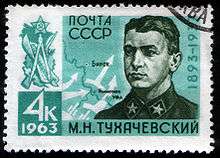
The plans received remarkable results in areas aside from agriculture. Russia, in many measures the poorest nation in Europe at the time of the Bolshevik Revolution, now industrialized at a phenomenal rate, far surpassing Germany's pace of industrialization in the 19th century and Japan's earlier in the 20th century.
While the Five-Year Plans were forging ahead, Stalin was establishing his personal power. The NKVD gathered in tens of thousands of Soviet citizens to face arrest, deportation, or execution. Of the six original members of the 1920 Politburo who survived Lenin, all were purged by Stalin. Old Bolsheviks who had been loyal comrades of Lenin, high officers in the Red Army, and directors of industry were liquidated in the Great Purges.[181] Purges in other Soviet republics also helped centralize control in the USSR.
Stalin's repressions led to the creation of a vast system of internal exile, of considerably greater dimensions than those set up in the past by the tsars.[182] Draconian penalties were introduced and many citizens were prosecuted for fictitious crimes of sabotage and espionage. The labor provided by convicts working in the labor camps of the Gulag system became an important component of the industrialization effort, especially in Siberia.[183][184] An estimated 18 million people passed through the Gulag system, and perhaps another 15 million had experience of some other form of forced labor.[185][186]
Soviet Union on the international stage
The Soviet Union viewed the 1933 accession of fervently anti-Communist Hitler's government to power in Germany with great alarm from the onset, especially since Hitler proclaimed the Drang nach Osten as one of the major objectives in his vision of the German strategy of Lebensraum.[187] The Soviets supported the republicans of Spain who struggled against fascist German and Italian troops in the Spanish Civil War.[188][189] In 1938–1939, immediately prior to WWII, the Soviet Union successfully fought against Imperial Japan in the Soviet–Japanese border conflicts in the Russian Far East, which led to Soviet-Japanese neutrality and the tense border peace that lasted until August 1945.[190][191]
In 1938 Germany annexed Austria and, together with major Western European powers, signed the Munich Agreement following which Germany, Hungary and Poland divided parts of Czechoslovakia between themselves. German plans for further eastward expansion, as well as the lack of resolve from Western powers to oppose it, became more apparent. Despite the Soviet Union strongly opposing the Munich deal and repeatedly reaffirming its readiness to militarily back commitments given earlier to Czechoslovakia, the Western Betrayal led to the end of Czechoslovakia and further increased fears in the Soviet Union of a coming German attack. This led the Soviet Union to rush the modernization of its military industry and to carry out its own diplomatic maneuvers. In 1939 the Soviet Union signed the Molotov–Ribbentrop Pact: a non-aggression pact with Nazi Germany dividing Eastern Europe into two separate spheres of influence.[192] Following the pact, the USSR normalized relations with Nazi Germany and resumed Soviet–German trade.[193]
World War II
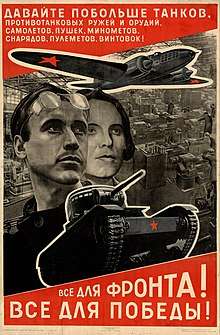
On 17 September 1939, sixteen days after the start of World War II and with the victorious Germans having advanced deep into Polish territory, the Red Army invaded eastern Poland, stating as justification the "need to protect Ukrainians and Belarusians" there, after the "cessation of existence" of the Polish state.[194][195] As a result, the Belarusian and Ukrainian Soviet republics' western borders were moved westward, and the new Soviet western border was drawn close to the original Curzon line. In the meantime negotiations with Finland over a Soviet-proposed land swap that would redraw the Soviet-Finnish border further away from Leningrad failed, and in December 1939 the USSR invaded Finland, beginning a campaign known as the Winter War (1939–40). The war took a heavy death toll on the Red Army but forced Finland to sign a Moscow Peace Treaty and cede the Karelian Isthmus and Ladoga Karelia.[196][197] In summer 1940 the USSR issued an ultimatum to Romania forcing it to cede the territories of Bessarabia and Northern Bukovina. At the same time, the Soviet Union also occupied the three formerly independent Baltic states (Estonia, Latvia and Lithuania).[198][199][200]
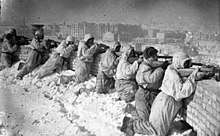

The peace with Germany was tense, as both sides were preparing for the military conflict,[202][203] and abruptly ended when the Axis forces led by Germany swept across the Soviet border on 22 June 1941. By the autumn the German army had seized Ukraine, laid a siege of Leningrad, and threatened to capture the capital, Moscow, itself.[204][205][206] Despite the fact that in December 1941 the Red Army threw off the German forces from Moscow in a successful counterattack, the Germans retained the strategic initiative for approximately another year and held a deep offensive in the south-eastern direction, reaching the Volga and the Caucasus. However, two major German defeats in Stalingrad and Kursk proved decisive and reversed the course of the entire World War as the Germans never regained the strength to sustain their offensive operations and the Soviet Union recaptured the initiative for the rest of the conflict.[207] By the end of 1943, the Red Army had broken through the German siege of Leningrad and liberated much of Ukraine, much of Western Russia and moved into Belarus.[208] By the end of 1944, the front had moved beyond the 1939 Soviet frontiers into eastern Europe. Soviet forces drove into eastern Germany, capturing Berlin in May 1945.[209] The war with Germany thus ended triumphantly for the Soviet Union.
_(B%26W).jpg)
As agreed at the Yalta Conference, three months after the Victory Day in Europe the USSR launched the Soviet invasion of Manchuria, defeating the Japanese troops in neighboring Manchuria, the last Soviet battle of World War II.[210]
Although the Soviet Union was victorious in World War II, the war resulted in around 26–27 million Soviet deaths (estimates vary)[211] and had devastated the Soviet economy in the struggle. Some 1,710 towns and 70,000 settlements were destroyed.[212] The occupied territories suffered from the ravages of German occupation and deportations of slave labor by Germany.[213] Thirteen million Soviet citizens became victims of the repressive policies of Germany and its allies in occupied territories, where people died because of mass murders, famine, absence of elementary medical aid and slave labor.[214][215][216][217] The Nazi Genocide of the Jews, carried out by German Einsatzgruppen along with local collaborators, resulted in almost complete annihilation of the Jewish population over the entire territory temporarily occupied by Germany and its allies.[218][219][220][221] During the occupation, the Leningrad region lost around a quarter of its population,[217] Soviet Belarus lost from a quarter to a third of its population, and 3.6 million Soviet prisoners of war (of 5.5 million) died in German camps.[222][223][224]
Cold War
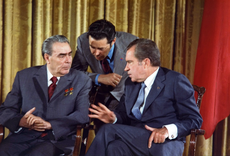
Collaboration among the major Allies had won the war and was supposed to serve as the basis for postwar reconstruction and security. However, the conflict between Soviet and U.S. national interests, known as the Cold War, came to dominate the international stage in the postwar period.
The Cold War emerged from a conflict between Stalin and U.S. President Harry Truman over the future of Eastern Europe during the Potsdam Conference in the summer of 1945.[225] Russia had suffered three devastating Western onslaughts in the previous 150 years during the Napoleonic Wars, the First World War, and the Second World War, and Stalin's goal was to establish a buffer zone of states between Germany and the Soviet Union.[226] Truman charged that Stalin had betrayed the Yalta agreement.[227] With Eastern Europe under Red Army occupation, Stalin was also biding his time, as his own atomic bomb project was steadily and secretly progressing.[228][229]
In April 1949 the United States sponsored the North Atlantic Treaty Organization (NATO), a mutual defense pact in which most Western nations pledged to treat an armed attack against one nation as an assault on all. The Soviet Union established an Eastern counterpart to NATO in 1955, dubbed the Warsaw Pact.[230][231][232] The division of Europe into Western and Soviet blocks later took on a more global character, especially after 1949, when the U.S. nuclear monopoly ended with the testing of a Soviet bomb and the Communist takeover in China.
The foremost objectives of Soviet foreign policy were the maintenance and enhancement of national security and the maintenance of hegemony over Eastern Europe. The Soviet Union maintained its dominance over the Warsaw Pact through crushing the Hungarian Revolution of 1956,[233] suppressing the Prague Spring in Czechoslovakia in 1968, and supporting the suppression of the Solidarity movement in Poland in the early 1980s. The Soviet Union opposed the United States in a number of proxy conflicts all over the world, including the Korean War and Vietnam War.
As the Soviet Union continued to maintain tight control over its sphere of influence in Eastern Europe, the Cold War gave way to Détente and a more complicated pattern of international relations in the 1970s in which the world was no longer clearly split into two clearly opposed blocs. Less powerful countries had more room to assert their independence, and the two superpowers were partially able to recognize their common interest in trying to check the further spread and proliferation of nuclear weapons in treaties such as SALT I, SALT II, and the Anti-Ballistic Missile Treaty.
U.S.–Soviet relations deteriorated following the beginning of the nine-year Soviet–Afghan War in 1979 and the 1980 election of Ronald Reagan, a staunch anti-communist, but improved as the communist bloc started to unravel in the late 1980s. With the collapse of the Soviet Union in 1991, Russia lost the superpower status that it had won in the Second World War.
De-Stalinization and the era of stagnation
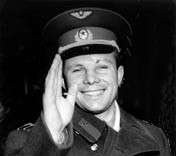
In the power struggle that erupted after Stalin's death in 1953, his closest followers lost out. Nikita Khrushchev solidified his position in a speech before the Twentieth Congress of the Communist Party in 1956 detailing Stalin's atrocities.[234]
In 1964 Khrushchev was impeached by the Communist Party's Central Committee, charging him with a host of errors that included Soviet setbacks such as the Cuban Missile Crisis.[234] After a period of collective leadership led by Leonid Brezhnev, Alexei Kosygin and Nikolai Podgorny, a veteran bureaucrat, Brezhnev, took Khrushchev's place as Soviet leader.[235] Brezhnev emphasized heavy industry,[236] instituted the Soviet economic reform of 1965,[237] and also attempted to ease relationships with the United States.[236] In the 1960s the USSR became a leading producer and exporter of petroleum and natural gas. Soviet science and industry peaked in the Khrushchev and Brezhnev years. The world's first nuclear power plant was established in 1954 in Obninsk, and the Baikal Amur Mainline was built.
The Soviet space program, founded by Sergey Korolev, was especially successful. On 4 October 1957 Soviet Union launched the first space satellite Sputnik.[238] On 12 April 1961 Yuri Gagarin became the first human to travel into space in the Soviet spaceship Vostok 1.[239] Other achievements of Russian space program include: the first photo of the far side of the Moon; exploration of Venus; the first spacewalk by Alexei Leonov; first female spaceflight by Valentina Tereshkova. More recently, the Soviet Union produced the world's first space station, Salyut which in 1986 was replaced by Mir, the first consistently inhabited long-term space station, that served from 1986 to 2001.
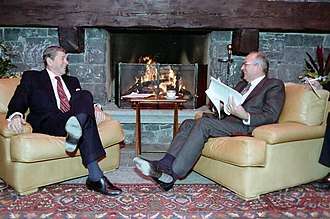
While all modernized economies were rapidly moving to computerization after 1965, the USSR fell further and further behind. Moscow's decision to copy the IBM 360 of 1965 proved a decisive mistake for it locked scientists into an antiquated system they were unable to improve. They had enormous difficulties in manufacturing the necessary chips reliably and in quantity, in programming workable and efficient programs, in coordinating entirely separate operations, and in providing support to computer users.[240][241]
One of the greatest strengths of Soviet economy was its vast supplies of oil and gas; world oil prices quadrupled in the 1973–74, and rose again in 1979–1981, making the energy sector the chief driver of the Soviet economy, and was used to cover multiple weaknesses. At one point, Soviet Premier Alexei Kosygin told the head of oil and gas production, "things are bad with bread. Give me 3 million tons [of oil] over the plan."[242] Former prime minister Yegor Gaidar, an economist looking back three decades, in 2007 wrote:
The hard currency from oil exports stopped the growing food supply crisis, increased the import of equipment and consumer goods, ensured a financial base for the arms race and the achievement of nuclear parity with the United States, and permitted the realization of such risky foreign-policy actions as the war in Afghanistan.[243]
Breakup of the Union
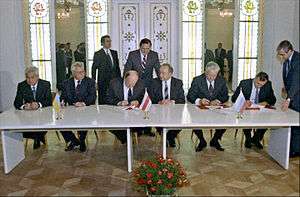
Two developments dominated the decade that followed: the increasingly apparent crumbling of the Soviet Union's economic and political structures, and the patchwork attempts at reforms to reverse that process. After the rapid succession of former KGB Chief Yuri Andropov and Konstantin Chernenko, transitional figures with deep roots in Brezhnevite tradition, Mikhail Gorbachev implemented perestroika in an attempt to modernize Soviet communism, and made significant changes in the party leadership. However, Gorbachev's social reforms led to unintended consequences. His policy of glasnost facilitated public access to information after decades of government repression, and social problems received wider public attention, undermining the Communist Party's authority. Glasnost allowed ethnic and nationalist disaffection to reach the surface, and many constituent republics, especially the Baltic republics, Georgian SSR and Moldavian SSR, sought greater autonomy, which Moscow was unwilling to provide. In the revolutions of 1989 the USSR lost its allies in Eastern Europe. Gorbachev's attempts at economic reform were not sufficient, and the Soviet government left intact most of the fundamental elements of communist economy. Suffering from low pricing of petroleum and natural gas, the ongoing war in Afghanistan, and outdated industry and pervasive corruption, the Soviet planned economy proved to be ineffective, and by 1990 the Soviet government had lost control over economic conditions. Due to price control, there were shortages of almost all products, reaching their peak in the end of 1991, when people had to stand in long lines and were lucky to buy even the essentials. Control over the constituent republics was also relaxed, and they began to assert their national sovereignty over Moscow.
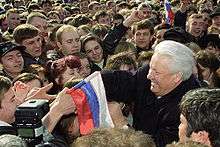
The tension between Soviet Union and Russian SFSR authorities came to be personified in the bitter power struggle between Gorbachev and Boris Yeltsin.[244] Squeezed out of Union politics by Gorbachev in 1987, Yeltsin, who represented himself as a committed democrat, presented a significant opposition to Gorbachev's authority. In a remarkable reversal of fortunes, he gained election as chairman of the Russian republic's new Supreme Soviet in May 1990.[245] The following month, he secured legislation giving Russian laws priority over Soviet laws and withholding two-thirds of the budget. In the first Russian presidential election in 1991 Yeltsin became president of the Russian SFSR. At last Gorbachev attempted to restructure the Soviet Union into a less centralized state. However, on 19 August 1991, a coup against Gorbachev, conspired by senior Soviet officials, was attempted. The coup faced wide popular opposition and collapsed in three days, but disintegration of the Union became imminent. The Russian government took over most of the Soviet Union government institutions on its territory. Because of the dominant position of Russians in the Soviet Union, most gave little thought to any distinction between Russia and the Soviet Union before the late 1980s. In the Soviet Union, only Russian SFSR lacked even the paltry instruments of statehood that the other republics possessed, such as its own republic-level Communist Party branch, trade union councils, Academy of Sciences, and the like.[246] The Communist Party of the Soviet Union was banned in Russia in 1991–1992, although no lustration has ever taken place, and many of its members became top Russian officials. However, as the Soviet government was still opposed to market reforms, the economic situation continued to deteriorate. By December 1991, the shortages had resulted in the introduction of food rationing in Moscow and Saint Petersburg for the first time since World War II. Russia received humanitarian food aid from abroad. After the Belavezha Accords, the Supreme Soviet of Russia withdrew Russia from the Soviet Union on 12 December. The Soviet Union officially ended on 25 December 1991,[247] and the Russian Federation (formerly the Russian Soviet Federative Socialist Republic)[248] took power on 26 December.[247] The Russian government lifted price control on January 1992. Prices rose dramatically, but shortages disappeared.
Russian Federation (1991–present)

Although Yeltsin came to power on a wave of optimism, he never recovered his popularity after endorsing Yegor Gaidar's "shock therapy" of ending Soviet-era price controls, drastic cuts in state spending, and an open foreign trade regime in early 1992 (see Russian economic reform in the 1990s). The reforms immediately devastated the living standards of much of the population. In the 1990s Russia suffered an economic downturn that was, in some ways, more severe than the United States or Germany had undergone six decades earlier in the Great Depression.[249] Hyperinflation hit the ruble, due to monetary overhang from the days of the planned economy.
Meanwhile, the profusion of small parties and their aversion to coherent alliances left the legislature chaotic. During 1993, Yeltsin's rift with the parliamentary leadership led to the September–October 1993 constitutional crisis. The crisis climaxed on 3 October, when Yeltsin chose a radical solution to settle his dispute with parliament: he called up tanks to shell the Russian White House, blasting out his opponents. As Yeltsin was taking the unconstitutional step of dissolving the legislature, Russia came close to a serious civil conflict. Yeltsin was then free to impose the current Russian constitution with strong presidential powers, which was approved by referendum in December 1993. The cohesion of the Russian Federation was also threatened when the republic of Chechnya attempted to break away, leading to the First and Second Chechen Wars.
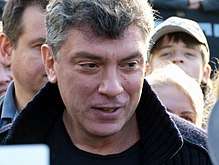
Economic reforms also consolidated a semi-criminal oligarchy with roots in the old Soviet system. Advised by Western governments, the World Bank, and the International Monetary Fund, Russia embarked on the largest and fastest privatization that the world had ever seen in order to reform the fully nationalized Soviet economy. By mid-decade, retail, trade, services, and small industry was in private hands. Most big enterprises were acquired by their old managers, engendering a new rich (Russian tycoons) in league with criminal mafias or Western investors.[250] Corporate raiders such as Andrei Volgin engaged in hostile takeovers of corrupt corporations by the mid-1990s.
By the mid-1990s Russia had a system of multiparty electoral politics.[251] But it was harder to establish a representative government because of two structural problems—the struggle between president and parliament and the anarchic party system.
Meanwhile, the central government had lost control of the localities, bureaucracy, and economic fiefdoms, and tax revenues had collapsed. Still in a deep depression, Russia's economy was hit further by the financial crash of 1998. After the crisis, Yeltsin was at the end of his political career. Just hours before the first day of 2000, Yeltsin made a surprise announcement of his resignation, leaving the government in the hands of the little-known Prime Minister Vladimir Putin, a former KGB official and head of the FSB, the KGB's post-Soviet successor agency.[252] In 2000, the new acting president defeated his opponents in the presidential election on 26 March, and won in a landslide four years later.[253] In 2001, Putin discussed with Bill Clinton the possibility of Russia joining NATO, without result.[254][255]
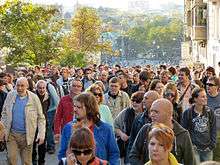
International observers were alarmed by moves in late 2004 to further tighten the presidency's control over parliament, civil society, and regional officeholders.[256] In 2008 Dmitri Medvedev, a former Gazprom chairman and Putin's head of staff, was elected new President of Russia. In 2012, Putin was once again elected as President.
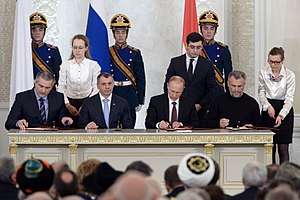
Russia had difficulty attracting foreign direct investment and experienced large capital outflows. Russia's long-term problems include a shrinking workforce, rampant corruption, and underinvestment in infrastructure.[257] Nevertheless, reversion to a socialist command economy seemed almost impossible.[258]
Russia ended 2006 with its eighth straight year of growth, averaging 6.7% annually since the financial crisis of 1998. Although high oil prices and a relatively cheap ruble initially drove this growth, since 2003 consumer demand and, more recently, investment have played a significant role.[257] Russia is well ahead of most other resource-rich countries in its economic development, with a long tradition of education, science, and industry.[259]
In 2014, following a referendum, in which separation was favored by a large majority of voters, the Russian leadership announced the accession of Crimea into the Russian Federation. The 2017–2018 Russian protests against alleged corruption in the federal Russian government took place in many Russian cities.[260] In the first half of 2019 there were approximately 863 protests across the country.[261]
Historiography
Historians
See also
- Dissolution of the Soviet Union
- Family tree of the Russian monarchs
- General Secretary of the Communist Party of the Soviet Union
- History of Central Asia
- History of Siberia
- History of the administrative division of Russia
- History of the Caucasus
- History of the Jews in Russia
- History of the Soviet Union
- List of heads of government of Russia
- List of Mongol and Tatar raids against Rus'
- List of presidents of Russia
- List of Russian explorers
- List of Russian historians
- List of Russian rulers
- List of wars involving Russia
- Military history of the Russian Empire
- Military history of the Soviet Union
- Politics of Russia
- Russia
- Russian Armed Forces
- Russian colonization of the Americas
- Russian Empire
- Russian Medical Fund
- Soviet Union
- Timeline of Moscow
- Timeline of Russian history
- Timeline of Russian innovation
- Timeline of Saint Petersburg
References
- "History of Russia – Slavs in Russia: from 1500 BC". Historyworld.net. Retrieved 14 July 2016.
- Hosking, Geoffrey; Service, Robert, eds. (1998). Russian Nationalism, Past and Present. Springer. p. 8. ISBN 9781349265329.
- "Повесть временных лет".
- Chepalyga, A.L.; Amirkhanov, Kh.A.; Trubikhin, V.M.; Sadchikova, T.A.; Pirogov, A.N.; Taimazov, A.I. (2011). "Geoarchaeology of the earliest paleolithic sites (Oldowan) in the North Caucasus and the East Europe". Archived from the original on 20 May 2013. Retrieved 18 December 2013.
Early Paleolithic cultural layers with tools of oldowan type was discovered in East Caucasus (Dagestan, Russia) by Kh. Amirkhanov (2006) [...]
- By K. Kris Hirst Archaeology Expert. "Pre-Aurignacian Levels Discovered at the Kostenki Site". Archaeology.about.com. Retrieved 18 May 2016.
- Igor V. Ovchinnikov; Anders Götherström; Galina P. Romanova; Vitaliy M. Kharitonov; Kerstin Lidén; William Goodwin (30 March 2000). "Molecular analysis of Neanderthal DNA from the northern Caucasus". Nature. 404 (6777): 490–493. Bibcode:2000Natur.404..490O. doi:10.1038/35006625. PMID 10761915.
- Mitchell, Alanna (30 January 2012). "Gains in DNA Are Speeding Research into Human Origins". The New York Times.
- Belinskij, Andrej; H. Härke (March–April 1999). "The 'Princess' of Ipatovo". Archeology. 52 (2). Archived from the original on 10 June 2008. Retrieved 26 December 2007.
- Drews, Robert (2004). Early Riders: The beginnings of mounted warfare in Asia and Europe. New York: Routledge. p. 50. ISBN 0-415-32624-9.
- Dr. Ludmila Koryakova, "Sintashta-Arkaim Culture" The Center for the Study of the Eurasian Nomads (CSEN). Retrieved 20 July 2007.
- 1998 NOVA documentary: "Ice Mummies: Siberian Ice Maiden" Transcript.
- Esther Jacobson, The Art of the Scythians: The Interpenetration of Cultures at the Edge of the Hellenic World, Brill, 1995, p. 38. ISBN 90-04-09856-9.
- Gocha R. Tsetskhladze (ed), The Greek Colonisation of the Black Sea Area: Historical Interpretation of Archaeology, F. Steiner, 1998, p. 48. ISBN 3-515-07302-7.
- Peter Turchin, Historical Dynamics: Why States Rise and Fall, Princeton University Press, 2003, pp. 185–186. ISBN 0-691-11669-5.
- David Christian, A History of Russia, Central Asia and Mongolia, Blackwell Publishing, 1998, pp. 286–288. ISBN 0-631-20814-3.
- Frank Northen Magill, Magill's Literary Annual, 1977 Salem Press, 1977, p. 818. ISBN 0-89356-077-4.
- André Wink, Al-Hind, the Making of an Indo-Islamic World, Brill, 2004, p. 35. ISBN 90-04-09249-8.
- András Róna-Tas, Hungarians and Europe in the Early Middle Ages: An Introduction to Early Hungarian History, Central European University Press, 1999, p. 257. ISBN 963-9116-48-3.
- Daniel H. Frank and Oliver Leaman, History of Jewish Philosophy, Routledge, 1997, p. 196. ISBN 0-415-08064-9.
- For a discussion of Slavic origins, see Paul M. Barford, The Early Slavs, Cornell University Press, 2001, pp. 15–16. ISBN 0-8014-3977-9.
- David Christian, op cit., pp. 6–7.
- Henry K Paszkiewicz, The Making of the Russian Nation, Darton, Longman & Todd, 1963, p. 262.
- Rosamond McKitterick, The New Cambridge Medieval History, Cambridge University Press, 1995, p. 497. ISBN 0-521-36447-7.
- Aleksandr Lʹvovich Mongaĭt, Archeology in the U.S.S.R., Foreign Languages Publishing House, 1959, p. 335.
- See, for instance, Viking (Varangian) Oleg and Viking (Varangian) Rurik at Encyclopædia Britannica.
- Dimitri Obolensky, Byzantium and the Slavs, St Vladimir's Seminary Press, 1994, p. 42. ISBN 0-88141-008-X.
- Kievan Rus' and Mongol Periods Archived 27 September 2007 at the Wayback Machine, excerpted from Glenn E. Curtis (ed.), Russia: A Country Study, Department of the Army, 1998. ISBN 0-16-061212-8.
- James Westfall Thompson, and Edgar Nathaniel Johnson, An Introduction to Medieval Europe, 300–1500, W. W. Norton & Co., 1937, p. 268.
- David Christian, Op cit. p. 343.
- Particularly among the aristocracy. See World History Archived 18 July 2007 at the Wayback Machine. Retrieved 22 July 2007.
- See Dimitri Obolensky, "Russia's Byzantine Heritage," in Byzantium & the Slavs, St Vladimir's Seminary Press, 1994, pp. 75–108. ISBN 0-88141-008-X.
- Serhii Plokhy, The Origins of the Slavic Nations: Premodern Identities in Russia, Ukraine, and Belarus, Cambridge University Press, 2006, p. 13. ISBN 0-521-86403-8.
- See The Christianisation of Russia, an account of Vladimir's baptism, followed by the baptism of the entire population of Kiev, as described in The Russian Primary Chronicle.
- Gordon Bob Smith, Reforming the Russian Legal System, Cambridge University Press, 1996, p. 2–3. ISBN 0-521-45669-X.
- P. N. Fedosejev, The Comparative Historical Method in Soviet Mediaeval Studies, USSR Academy of Sciences, 1979. p. 90.
- Russell Bova, Russia and Western Civilization: Cultural and Historical Encounters, M.E. Sharpe, 2003, p. 13. ISBN 0-7656-0976-2.
- Timothy Ware: The Orthodox Church (Penguin, 1963; 1997 revision) p.74
- In 1240. See Michael Franklin Hamm, Kiev: A Portrait, 1800–1917, Princeton University Press, 1993. ISBN 0-691-02585-1
- See David Nicolle, Kalka River 1223: Genghis Khan's Mongols Invade Russia, Osprey Publishing, 2001. ISBN 1-84176-233-4.
- Tatyana Shvetsova, The Vladimir Suzdal Principality Archived 20 March 2008 at the Wayback Machine. Retrieved 21 July 2007.
- Janet Martin, Medieval Russia, 980–1584, Cambridge University Press, 1995, p. 139. ISBN 0-521-36832-4.
- The Destruction of Kiev
- Jennifer Mills, The Hanseatic League in the Eastern Baltic Archived 29 June 2011 at the Wayback Machine, SCAND 344, May 1998. Retrieved 21 July 2007.
- Muscovy, excerpted from Glenn E. Curtis (ed.), Russia: A Country Study, Department of the Army, 1998. ISBN 0-16-061212-8.
- Sigfried J. De Laet, History of Humanity: Scientific and Cultural Development, Taylor & Francis, 2005, p. 196. ISBN 92-3-102814-6.
- The Battle of Kulikovo (8 September 1380) Archived 7 June 2007 at the Wayback Machine. Retrieved 22 July 2007.
- "History of the Mongols". History World. Retrieved 26 July 2007.
- Ivan III Archived 6 August 2007 at the Wayback Machine, The Columbia Encyclopedia, Sixth Edition. 2001–05.
- Ivan III, Encyclopædia Britannica. 2007
- Donald Ostrowski in The Cambridge History of Russia, Cambridge University Press, 2006, p. 234. ISBN 0-521-81227-5.
- See e.g. Eastern Orthodoxy, Encyclopædia Britannica. 2007. Encyclopædia Britannica.
- "The Tatar Khanate of Crimea". Archived from the original on 8 November 2017. Retrieved 12 July 2009.
- J. L. I. Fennell, Ivan the Great of Moscow (1961) p 354
- Tim McDaniel. "Autocracy, Modernization, and Revolution in Russia and Iran". Princeton University Press, 14 July 2014 ISBN 1400861624 p 64
- Kevin O'Connor. "The History of the Baltic States" Greenwood Publishing Group, 1 January 2003 ISBN 0313323550 p 23
- "Ivan the Terrible". Minnesota State University Mankato. Archived from the original on 18 July 2007. Retrieved 23 July 2007.
- Zenkovsky, Serge A. (October 1957). "The Russian Church Schism: Its Background and Repercussions". Russian Review. Blackwell Publishing. 16 (4): 37–58. doi:10.2307/125748. JSTOR 125748.
- Skrynnikov R., "Ivan Grosny", p.58, M., AST, 2001
- William Urban. "THE ORIGIN OF THE LIVONIAN WAR, 1558". LITHUANIAN QUARTERLY JOURNAL OF ARTS AND SCIENCES. Retrieved 23 July 2007.
- Janet Martin, Medieval Russia, 980–1584, Cambridge University Press, 1995, p. 395. ISBN 0-521-36832-4.
- Siberian Chronicles, Строгановская Сибирская Летопись. изд. Спаским, СПб, 1821
- Skrynnikov R. "Ivan Grozny", M, 2001, pp.142–173
- Robert I. Frost The Northern Wars: 1558–1721 (Longman, 2000) pp.26–27
- "Gulliver".
- Skrynnikov. "Ivan Grozny", M, 2001, pp.222–223
- Borisenkov E, Pasetski V. "The thousand-year annals of the extreme meteorological phenomena", ISBN 5-244-00212-0, p.190
- Solovyov. "History of Russia...", v.7, pp.533–535, pp.543–568
- Lev Gumilev (1992), Ot Rusi k Rossii. Ocherki e'tnicheskoj istorii [From Rus' to Russia], Moscow: Ekopros.
- Michel Heller (1997), Histoire de la Russie et de son empire [A history of Russia and its empire], Paris: Plon.
- George Vernadsky, "A History of Russia", Volume 5, Yale University Press, (1969). Russian translation
- Mikolaj Marchocki "Historia Wojny Moskiewskiej", ch. "Slaughter in the capital", Russian translation
- Sergey Solovyov. History of Russia... Vol. 8, p. 847
- Chester S L Dunning, Russia's First Civil War: The Time of Troubles and the Founding of the Romanov Dynasty, p. 434 Penn State Press, 2001, ISBN 0-271-02074-1
- Troubles, Time of." Encyclopædia Britannica. 2006
- Pozharski, Dmitri Mikhailovich, Prince", Columbia Encyclopedia
- For a discussion of the development of the class structure in Tsarist Russia see Skocpol, Theda. States and Social Revolutions: A Comparative Analysis of France, Russia, and China. Cambridge U Press, 1988.
- Jarmo Kotilaine and Marshall Poe, Modernizing Muscovy: Reform and Social Change in Seventeenth-Century Russia, Routledge, 2004, p. 264. ISBN 0-415-30751-1.
- (in Russian) Moscow Uprising of 1682 in the History of Russia of Sergey Solovyov
- Brian Catchpole, A Map History of Russia (1974) pp 8–31; MArtin Gilbert, Atlas of Russian history (1993) pp 33–74.
- James Cracraft, The Revolution of Peter the Great (2003) online edition
- Basil Dmytryshyn, "Russian expansion to the Pacific, 1580–1700: a historiographical review." Slavic Studies 25 (1980): 1–25. online.
- "Milov L.V. "Russian peasant and features of the Russian historical process", the research of Russian economic history of 15th–18th centuries".
- Lord Kinross, The Ottoman Centuries: The Rise and Fall of the Turkish Empire (1979) p. 353.
- Hughes, Lindsey (2000). Russia in the Age of Peter the Great. Yale University Press. ISBN 9780300082661.
- Stephen J. Lee (2013). Peter the Great. Routledge. p. 31. ISBN 9781136453250.
- Alexander, John T. (1988). Catherine the Great: Life and Legend. Oxford University Press. ISBN 9780199878857.
- de Madariaga, Isabel (2002). Catherine the Great: A Short History. Yale University Press. ISBN 9780300097221.
- Kenneth C. Campbell (2015). Western Civilization: A Global and Comparative Approach: Since 1600: Volume II: Since 1600. Routledge. p. 86. ISBN 9781317452300.
- de Madariaga, Isabel (2002). Russia in the Age of Catherine the Great. Phoenix. ISBN 9781842125113.
- Campbell (28 January 2015). Western Civilization. p. 86. ISBN 9781317452300.
- "History". Parallel 60. Archived from the original on 21 January 2010. Retrieved 23 July 2007.
- According to Brockhaus and Efron Encyclopedic Dictionary: 1891 Grodno province – Catholics 384,696, total population 1,509,728 ; Curland province – Catholics 68,722, total population 555,003 ; Volyhnia Province – Catholics 193,142, total population 2,059,870
- Thomas McLean, The Other East and Nineteenth-Century British Literature: Imagining Poland and the Russian Empire (Palgrave Macmillan, 2012) pp. 14-40.
- Alfred J. Rieber, "Persistent factors in Russian foreign policy: an interpretive essay." in Hugh Ragsdale, ed., Imperial Russian Foreign Policy (1993) p 328.
- Riasanovsky, Nicholas (1984). A History of Russia (4th ed.). Oxford University Press. p. 284. ISBN 978-0195033618.
- Timothy C. Dowling Russia at War: From the Mongol Conquest to Afghanistan, Chechnya, and Beyond pp 728–729 ABC-CLIO, 2 December 2014 ISBN 1598849484
- Charles Esdaile, Napoleon's Wars: An International History, 1803–1815 (2007) p 438
- Paul W. Schroeder, The Transformation of European Politics: 1763 – 1848 (1994) p 419
- Esdaile, Napoleon's Wars: An International History, 1803–1815 (2007) pp 460–80
- Palmer, Alan (2014). Alexander I: Tsar of War and Peace. Faber & Faber. ISBN 9780571305872.
- Parker, W.H. (1968). An historical geography of Russia. University of London Press. p. 193. ISBN 978-0340069400.
- Geoffrey Best, War and Society in Revolutionary Europe, 1770–1870 (1998) p. 187
- Riasonovsky A History of Russia (fifth ed.) pp.302–3; Charques A Short History of Russia (Phoenix, second ed. 1962) p.125
- Riasonovsky p.302-307
- Christopher Browning; Marko Lehti (2009). The Struggle for the West: A Divided and Contested Legacy. Routledge. p. 36. ISBN 9781135259792.
- Timothy C. Dowling Russia at War: From the Mongol Conquest to Afghanistan, Chechnya, and Beyond (2014) pp 729
- Riasonovsky p.308
- Stephen R. Burant, "The January Uprising of 1863 in Poland: Sources of Disaffection and the Arenas of Revolt." European History Quarterly 15#2 (1985): 131–156.
- Olga E. Maiorova, "War as Peace: The Trope of War in Russian Nationalist Discourse during the Polish Uprising of 1863." Kritika: Explorations in Russian and Eurasian History 6#3 (2005): 501–534.
- Norman Davies: God's Playground: A History of Poland (OUP, 1981) vol. 2, pp.315–333; and 352-63
- Curtiss, John Shelton (1958). "The Army of Nicholas I: Its Role and Character". American Historical Review. 63 (4): 880–889 [quote p. 886]. doi:10.2307/1848945. JSTOR 1848945.
- Fuller (1 October 1998). Strategy and Power in Russia 1600–1914. p. 273. ISBN 9781439105771.
- Barbara Jelavich, St. Petersburg and Moscow: Tsarist and Soviet Foreign Policy, 1814–1974 (1974) p 119
- William C. Fuller, Strategy and Power in Russia 1600–1914 (1998) pp 252–59
- Chapman, Tim (2001). Imperial Russia: 1801–1905. Routledge. pp. 60–65. ISBN 9780415231091 – via Questia.
- Stein, Howard F. (1976). "Russian Nationalism and the Divided Soul of the Westernizers and Slavophiles". Ethos. 4 (4): 403–438. doi:10.1525/eth.1976.4.4.02a00010.
- Janko Lavrin, "Chaadayev and the West." Russian Review 22.3 (1963): 274–288 online.
- Raymond T. McNally, "The Significance of Chaadayev's Weltanschauung." Russian Review 23.4 (1964): 352–361. online
- Neil Cornwell, "Belinsky and V.F. Odoyevsky." Slavonic and East European Review 62.1 (1984): 6–24. online
- Kantor, Vladimir K. (2012). "The tragedy of Herzen, or seduction by radicalism". Russian Studies in Philosophy. 51 (3): 40–57. doi:10.2753/rsp1061-1967510303.
- Michael Kort (2008). A Brief History of Russia. Infobase. p. 92. ISBN 9781438108292.
- Rene Albrecht-Carrie, A Diplomatic History of Europe Since the Congress of Vienna (1973) pp 84–94
- Figes, Orlando (2011). The Crimean War: A History. Henry Holt and Company. ISBN 9781429997249.
- Orlando Figes, The Crimean War, (2010) pp 442–443.
- William C. Fuller (1998). Strategy and Power in Russia 1600–1914. p. 273. ISBN 9781439105771.
- Thomas Nemeth. "Russian Philosophy". The Internet Encyclopedia of Philosophy. Retrieved 23 July 2007.
- Excerpt from "Enserfed population in Russia" published at Демоскоп Weekly, No 293 – 294, 18 June 1 July 2007
- Emmons, Terence, ed. (1970). Emancipation of the Russian Serfs. Holt, Rinehart and Winston. ISBN 9780030773600.
- Evgeny Finkel, Scott Gehlbach, and Tricia D. Olsen. "Does reform prevent rebellion? Evidence from Russia’s emancipation of the serfs." Comparative Political Studies 48.8 (2015): 984-1019. online
- Mosse, W. E. (1958). Alexander II and the Modernization of Russia. London: English Universities Press – via Questia.
- Riasonovsky pp.386–7
- Riasonovsky p.349
- Riasonovsky pp.381–2, 447–8
- I. K. Shakhnovskiĭ (1921). A Short History of Russian Literature. K. Paul, Trench, Trubner. p. 147.
- E. Heier (2012). Religious Schism in the Russian Aristocracy 1860–1900: Radstockism and Pashkovism. pp. 5–7. ISBN 9789401032285.
- Transformation of Russia in the Nineteenth Century, excerpted from Glenn E. Curtis (ed.), Russia: A Country Study, Department of the Army, 1998. ISBN 0-16-061212-8.
- Waldron, Peter (2006). "Alexander II". Europe 1789–1914: Encyclopedia of the Age of Industry and Empire. 1: 40 – via GALE World History in Context.
- "Orthodoxy, Autocracy, and Nationality". Encyclopædia Britannica. 26 January 2016.
- Hugo S. Cunninggam, Konstantin Petrovich Pobedonostsev (1827–1907): Reactionary Views on Democracy, General Education. Retrieved 21 July 2007.
- Robert F. Byrnes, "Pobedonostsev: His Life and Thought" in Political Science Quarterly, Vol. 85, No. 3 (September 1970), pp. 528–530.
- Arthur E. Adams, "Pobedonostsev's Religious Politics" in Church History, Vol. 22, No. 4 (December 1953), pp. 314–326.
- Hugh Seton-Watson, The Russian Empire 1801–1917 (Oxford History of Modern Europe) (1967), pp 598–627
- For an analysis of the reaction of the elites to the revolutionaries see Roberta Manning, The Crisis of the Old Order in Russia: Gentry and Government. (1982).
- The Last Years of the Autocracy, excerpted from Glenn E. Curtis (ed.), Russia: A Country Study, Department of the Army, 1998. ISBN 0-16-061212-8.
- Orlando Figes, Revolutionary Russia, 1891–1991: A History (2014) pp 1–33
- Figes, Revolutionary Russia, 1891–1991: A History (2014) pp 33–43
- Levy, Jack S.; Mulligan, William (2017). "Shifting power, preventive logic, and the response of the target: Germany, Russia, and the First World War". Journal of Strategic Studies. 40 (5): 731–769. doi:10.1080/01402390.2016.1242421.
- Clark, Christopher (2013). The Sleepwalkers: How Europe Went to War in 1914. HarperCollins. ISBN 978-0-06-219922-5. p509.
- W. Bruce Lincoln, Passage Through Armageddon: The Russians in War and Revolution, 1914–1918 (1986)
- Nicholas Riasanovsky, A History of Russia (4th ed. 1984) p 418-20
- "Refugees (Russian Empire) | International Encyclopedia of the First World War (WW1)".
- Richard Charques (1974). The Twilight of Imperial Russia. Oxford U.P. p. 232. ISBN 9780195345872.
- Alexander Rabinowitch (2008). The Bolsheviks in Power: The First Year of Soviet Rule in Petrograd. Indiana UP. p. 1. ISBN 978-0253220424.
- Rex A. Wade (2005). The Russian Revolution, 1917. Cambridge U.P. pp. 29–50. ISBN 9780521841559.
- Riasanovsky, A History of Russia (4th ed. 1984) pp 455–56
- The Russian Revolution in the History Channel Encyclopedia.
- Riasanovsky, A History of Russia (4th ed. 1984) pp 456–60
- Richard Pipes (2011). The Russian Revolution. p. 411. ISBN 9780307788573.
- Riasanovsky, A History of Russia (4th ed. 1984) pp 460–61
- W. Bruce Lincoln, Red Victory: A History of the Russian Civil War, 1918–1921 (1999)
- See Orlando Figes: A People's Tragedy (Pimlico, 1996) passim
- Florinsky, Michael T. (1961). Encyclopedia of Russia and the Soviet Union. McGraw-Hill. p. 258. Retrieved 22 July 2009.
- Rinke, Stefan; Wildt, Michael (2017). Revolutions and Counter-Revolutions: 1917 and Its Aftermath from a Global Perspective. Campus Verlag. pp. 57–58. ISBN 978-3593507057.
- Ryan, James (2012). Lenin's Terror: The Ideological Origins of Early Soviet State Violence. London: Routledge. p. 114. ISBN 978-1-138-81568-1.CS1 maint: ref=harv (link)
- The Anatomy of Revolution Revisited: A Comparative Analysis of England, France, and Russia. Bailey Stone. Cambridge University Press, 25 November 2013. p. 335
- "The Russian Revolution", Richard Pipes, Knopf Doubleday Publishing Group, 13 July 2011, p. 838
- Ryan (2012), p. 2.
- Lincoln, W. Bruce (1989). Red Victory: A History of the Russian Civil War. Simon & Schuster. p. 384. ISBN 0671631667.
...the best estimates set the probable number of executions at about a hundred thousand.
- Lowe (2002), p. 151.
- And Now My Soul Is Hardened: Abandoned Children in Soviet Russia, 1918–1930, Thomas J. Hegarty, Canadian Slavonic Papers
- "Tsar Killed, USSR Formed," in 20th Century Russia. Retrieved 21 July 2007.
- Soviet Union Information Bureau, Area and Population. Retrieved 21 July 2007.
- Richman, Sheldon L. (1981). "War Communism to NEP: The Road to Serfdom" (PDF). The Journal of Libertarian Studies. 5 (1): 89–97.
- Baten, Jörg; Behle, Dominic (2010). "Regional Determinants of Firm Creation in the Russian Empire. Evidence from the 1870 Industrial Exhibition". Russian Economic History Yearbook. 01 – via Researchgate.
- McElvanney, Katie. "Women and the Russian Revolution". British Library. Retrieved 11 May 2020.
- Pushkareva, Natalia. "Marriage in Twentieth Century Russia: Traditional Precepts and Innovative Experiments" (.doc). Russian Academy of Sciences. Retrieved 23 July 2007.
- Remennick, Larissa (1991). "Epidemology and Determinants of Induced Abortion in the USSR". Soc. Sci. Med. 33 (7): 841–848. doi:10.1016/0277-9536(91)90389-T. PMID 1948176.
- I. Deutscher, Stalin: A Political Biography, Oxford University Press, 1949, pp. 294–344.
- Conquest, Robert. The Harvest of Sorrow: Soviet Collectivization and the Terror-Famine. New York: Oxford University Press, 1987. ISBN 0-19-505180-7.
- Viola, Lynne. Peasant Rebels under Stalin. Collectivization and the Culture of Peasant Resistance. 2nd ed. New York: Oxford University Press, 1998. ISBN 0-19-513104-5.
- Conquest, Robert. The Great Terror: A Reassessment. New York: Oxford University Press, 1990. ISBN 0-19-507132-8.
- "The Gulag Collection: Paintings of Nikolai Getman". Archived from the original on 31 October 2007.
- Gregory, Paul R. & Valery Lazarev (eds.). The Economics of Forced Labor: The Soviet Gulag. Stanford: Hoover Institution Press, 2003. ISBN 0-8179-3942-3.
- Ivanova, Galina M. Labor Camp Socialism: The Gulag in the Soviet Totalitarian System. Armonk, NY: M. E. Sharpe, 2000. ISBN 0-7656-0427-2.
- "Anne Applebaum – Inside the Gulag". Archived from the original on 15 October 2008.
- Applebaum, Anne. Gulag: A History of the Soviet Camps. London: Penguin Books, 2003. ISBN 0-7139-9322-7.
- See, e.g. Mein Kampf
- Payne, Stanley G. The Spanish Civil War, the Soviet Union, and Communism. New Haven: Yale University Press, 2004. ISBN 0-300-10068-X.
- Radosh, Ronald, Mary Habeck & Grigory Sevostianov (eds.). Spain Betrayed: The Soviet Union in the Spanish Civil War. New Haven: Yale University Press, 2001. ISBN 0-300-08981-3.
- Coox, Alvin D. The Anatomy of a Small War: The Soviet-Japanese Struggle for Changkufeng/Khasan, 1938. Westport, CT: Greenwood Press, 1977. ISBN 0-8371-9479-2.
- Coox, Alvin D. Nomonhan: Japan against Russia, 1939. 2 vols. Stanford: Stanford University Press, 1990. ISBN 0-8047-1835-0.
- Roberts, Geoffrey (1992). "The Soviet Decision for a Pact with Nazi Germany". Soviet Studies. 44 (1): 57–78. doi:10.1080/09668139208411994. JSTOR 00385859.
- Ericson, Edward E. Feeding the German Eagle: Soviet Economic Aid to Nazi Germany, 1933–1941. New York: Praeger, 1999. ISBN 0-275-96337-3.
- Gross, Jan Tomasz. Revolution from Abroad: The Soviet Conquest of Poland's Western Ukraine and Western Belorussia. Princeton: Princeton University Press, 2002. 2nd ed. ISBN 0-691-09603-1.
- Zaloga, Steven & Victor Madej. The Polish Campaign 1939. 2nd ed. New York: Hippocrene Books, 1991. ISBN 0-87052-013-X.
- Vehviläinen, Olli. Finland in the Second World War: Between Germany and Russia. New York: Palgrave, 2002. ISBN 0-333-80149-0
- Van Dyke, Carl. The Soviet Invasion of Finland 1939–1940. London: Frank Cass, 1997. ISBN 0-7146-4314-9.
- Dima, Nicholas. Bessarabia and Bukovina: The Soviet-Romanian Territorial Dispute. Boulder, CO: East European Monographs, 1982. ISBN 0-88033-003-1.
- Tarulis, Albert N. Soviet Policy Toward the Baltic States 1918–1940. Notre Dame, IN: University of Notre Dame Press, 1959.
- Misiunas, Romuald J. & Rein Taagepera. The Baltic States: The Years of Dependence, 1940–90. 2nd ed. London: Hurst & Co, 1993. ISBN 1-85065-157-4.
- "Leaders mourn Soviet wartime dead". 9 May 2005 – via news.bbc.co.uk.
- А. В. Десять мифов Второй мировой. – М.: Эксмо, Яуза, 2004, ISBN 5-699-07634-4
- Mikhail Meltyukhov, Stalin's Missed Chance, М. И. Мельтюхов Упущенный шанс Сталина: Советский Союз и борьба за Европу 1939–1941 гг. : Документы, факты, суждения. Изд. 2-е, испр., доп. ISBN 5-7838-1196-3 (second edition)
- Gilbert, Martin. The Second World War: A Complete History. 2nd ed. New York: Owl Books, 1991. ISBN 0-8050-1788-7.
- Thurston, Robert W. & Bernd Bonwetsch (ed.). The People's War: Responses to World War II in the Soviet Union. Urbana: University of Illinois Press, 2000. ISBN 0-252-02600-4.
- Clark, Alan. Barbarossa: The Russian-German Conflict, 1941–1945. New York: Harper Perennial, 1985. ISBN 0-688-04268-6.
- Beevor, Antony. Stalingrad, The Fateful Siege: 1942–1943. New York: Viking, 1998. ISBN 0-670-87095-1.
- Glantz, David M. & Jonathan M. House. When Titans Clashed: How the Red Army Stopped Hitler. Lawrence: University Press of Kansas, 1998. ISBN 0-7006-0717-X.
- Beevor, Antony. Berlin: The Downfall, 1945. 3rd ed. London: Penguin Books, 2004. ISBN 0-14-101747-3.
- Glantz, David M. The Soviet 1945 Strategic Offensive in Manchuria: 'August Storm'. London: Routledge, 2003. ISBN 0-7146-5279-2.
- This is far higher than the original number of 7 million given by Stalin, and, indeed, the number has increased under various Soviet and Russian Federation leaders. See Mark Harrison, The Economics of World War II: Six Great Powers in International Comparison, Cambridge University Press, 1998, p. 291 (ISBN 0-521-78503-0), for more information.
- As evidenced at the post-war Nuremberg Trials. See Ginsburg, George, The Nuremberg Trial and International Law, Martinus Nijhoff, 1990, p. 160. ISBN 0-7923-0798-4.
- "Final Compensation Pending for Former Nazi Forced Laborers | DW | 27.10.2005". DW.COM.
- Gerlach, C. "Kalkulierte Morde" Hamburger Edition, Hamburg, 1999
- Россия и СССР в войнах ХХ века", М. "Олма- Пресс", 2001 год
- Цена войны (Борис ЯЧМЕНЕВ) – "Трудовая Россия" Archived 27 September 2007 at the Wayback Machine. Tr.rkrp-rpk.ru. Retrieved 16 February 2011.
- Рыбаковский Л. Великая отечественная: людские потери России. Gumer.info. Retrieved 16 February 2011.
- "Involvement of the Lettish SS Legion in War Crimes in 1941–1945 and the Attempts to Revise the Verdict of the Nuremberg Tribunal in Latvia". Permanent Mission of the Russian Federation to the United Nations. United Nations. Archived from the original on 13 January 2009.
- Permanent Mission of the Russian Federation to the United Nations (Russian Federation. General Information) Archived 11 May 2009 at the Wayback Machine. United Nations. Retrieved 16 February 2011.
- "July 25: Pogrom in Lvov". Chronology of the Holocaust. Yad Vashem. Archived from the original on 11 March 2005.
- "It Took Nerves of Steel". Archived from the original on 6 June 2007.
- "Case Study: Soviet Prisoners-of-War (POWs), 1941–42". Gendercide Watch. Retrieved 22 July 2007.
- "Soviet Casualties and Combat Losses in the Twentieth Century", Greenhill Books, London, 1997, G. F. Krivosheev
- Christian Streit: Keine Kameraden: Die Wehrmacht und die Sowjetischen Kriegsgefangenen, 1941–1945, Bonn: Dietz (3. Aufl., 1. Aufl. 1978), ISBN 3-8012-5016-4
- "The Cold War". John F. Kennedy Presidential Library and Museum.
- Gaddis, John Lewis (1990). Russia, the Soviet Union, and the United States: An Interpretive History. McGraw-Hill. p. 176. ISBN 0-07-557258-3.
- Theoharis, Athan (1972). "Roosevelt and Truman on Yalta: The Origins of the Cold War". Political Science Quarterly. 87 (2): 226. doi:10.2307/2147826. JSTOR 2147826.
- Cochran, Thomas B., Robert S. Norris & Oleg Bukharin. Making the Russian Bomb: From Stalin to Yeltsin Archived 9 August 2007 at the Wayback Machine (PDF). Boulder,. CO:. Westview Press, 1995. ISBN 0-8133-2328-2.
- Gaddis, John Lewis. We Now Know: Rethinking Cold War History. Oxford: Clarendon press, 1997. ISBN 0-19-878071-0.
- Mastny, Vojtech, Malcolm Byrne & Magdalena Klotzbach (eds.). Cardboard Castle?: An Inside History of the Warsaw Pact, 1955–1991. Budapest: Central European University Press, 2005. ISBN 963-7326-08-1.
- Holloway, David & Jane M. O. Sharp. The Warsaw Pact: Alliance in Transition? Ithaca: Cornell University Press, 1984. ISBN 0-8014-1775-9.
- Holden, Gerard. The Warsaw Pact: Soviet Security and Bloc Politics. Oxford: Blackwell, 1989. ISBN 0-631-16775-7.
- Litvan, Gyorgy, Janos M. Bak & Lyman Howard Legters (eds.). The Hungarian Revolution of 1956: Reform, Revolt and Repression, 1953–1963. London – New York: Longman, 1996. ISBN 0-582-21504-8.
- "Nikita Sergeyevich Khrushchev". CNN. Archived from the original on 13 June 2008. Retrieved 22 July 2007.
- "Leonid Ilyich Brezhnev". CNN. Archived from the original on 13 June 2008. Retrieved 22 July 2007.
- "Leonid Brezhnev, 1906–1982". The History Guide. Retrieved 22 July 2007.
During the 1970s Brezhnev attempted to normalize relations between West Germany and the Warsaw Pact and to ease tensions with the United States through the policy known as détente. At the same time, he saw to it that the Soviet Union's military-industrial complex was greatly expanded and modernized.", "After his death, he was criticized for a gradual slide in living standards, the spread of corruption and cronyism within the Soviet bureaucracy, and the generally stagnant and dispiriting character of Soviet life in the late 1970s and early '80s.
- "Soviet and Post-Soviet Economic Structure And Performance". HArper Collins. Archived from the original on 10 December 2012.
- Steve Garber (19 January 2007). "Sputnik and The Dawn of the Space Age". NASA. Retrieved 22 July 2007.
History changed on October 4, 1957, when the Soviet Union successfully launched Sputnik I. The world's first artificial satellite...
- Neil Perry (12 April 2001). "Yuri Gagarin". The Guardian. UK. Retrieved 22 July 2007.
12 April 2001 is the fortieth anniversary of Yuri Gagarin's flight into space, the first time a human left the planet
- James W. Cortada, "Public Policies and the Development of National Computer Industries in Britain, France, and the Soviet Union, 1940—80." Journal of Contemporary History (2009) 44#3 pp: 493–512, especially page 509-10.
- Cain, Frank (2005). "Computers and the Cold War: United States Restrictions on the Export of Computers to the Soviet Union and Communist China". Journal of Contemporary History. 40 (1): 131–147. doi:10.1177/0022009405049270. JSTOR 30036313.
- Yergin, The Quest (2011) p 23
- Yegor Gaidar (2007). Collapse of an Empire: Lessons for Modern Russia. Brookings Institution Press. p. 102. ISBN 978-0815731153.
- David Pryce-Jones (20 March 2000). "Boris on a Pedestal". National Review. Archived from the original on 2 June 2007. Retrieved 22 July 2007.
In the process he engaged in a power struggle with Mikhail Gorbachev...
- "Boris Yeltsin". CNN. Archived from the original on 13 June 2008. Retrieved 22 July 2007.
The first-ever popularly elected leader of Russia, Boris Nikolayevich Yeltsin was a protégé of Mikhail Gorbachev's.
- "Government". Country Studies. Retrieved 22 July 2007.
Because of the Russians' dominance in the affairs of the union, the RSFSR failed to develop some of the institutions of governance and administration that were typical of public life in the other republics: a republic-level communist party, a Russian academy of sciences, and Russian branches of trade unions, for example.
- "Timeline: Soviet Union". BBC. 3 March 2006. Retrieved 22 July 2007.
1991 25 December – Gorbachev resigns as Soviet president; US recognises independence of remaining Soviet republics
- "Russian Soviet Federal Socialist Republic". The Free Dictionary. Retrieved 22 July 2007.
The largest republic of the former Soviet Union; it became independent as the Russian Federation in 1991
- Peter Nolan, China's Rise, Russia's Fall. Macmillan Press, 1995. pp. 17–18.
- Fairbanks, Jr.; Charles, H. (1999). "The Feudalization of the State". Journal of Democracy. 10 (2): 47–53. doi:10.1353/jod.1999.0031.
- "Russian president praises 1990s as cradle of democracy". Johnson's Russia List. Archived from the original on 11 July 2007. Retrieved 20 July 2007.
- CNN Apologetic Yeltsin resigns; Putin becomes acting president Archived 13 November 2007 at the Wayback Machine. Written by Jim Morris. Published 31 December 1999.
- "Putin's hold on the Russians". BBC. 28 June 2007. Retrieved 22 July 2007.
In the 2000 election, he took 53% of the vote in the first round and, four years later, was re-elected with a landslide majority of 71%.
- Putin wants NATO to let Russia join, Deseret News, 18 July 2001
- Putin discussed Russia's possible NATO membership with Bill Clinton, Radio Free Europe/Radio Liberty/Radio Liberty, 3 June 2017
- "Putin's hold on the Russians". BBC. 28 June 2007. Retrieved 22 July 2007.
But his critics believe that it has come at the cost of some post-communist democratic freedoms.", "2003: General election gives Putin allies control over parliament"
- CIA World Fact Book – Russia
- "The Russian Federation Today". Guide to Russia's HISTORY OF RUSSIA. Archived from the original on 7 May 2012. Retrieved 12 August 2013.
- Russia: How Long Can The Fun Last? Bloomberg BusinessWeek
- Bershidsky, Leonid (26 April 2017). "Russian Polls Do Mean Something After All". Bloomberg.
- "Russian Officials Appear Unable to Suppress Protests". VOA News. 7 October 2019.
Further reading
Surveys
- Auty, Robert, and Dimitri Obolensky, eds. Companion to Russian Studies: vol 1: An Introduction to Russian History (1981) 403pp; surveys by scholars.
- Brown, Archie et al. eds. The Cambridge Encyclopedia of Russia and the Former Soviet Union (2nd ed. 1994) 664pp
- Bushkovitch, Paul. A Concise History of Russia (2011) excerpt and text search
- Figes, Orlando. Natasha's Dance: A Cultural History of Russia (2002). excerpt
- Freeze, Gregory L., ed.,. Russia: A History. 2nd ed. New York: Oxford University Press, 2002. ISBN 0-19-860511-0.
- Harcave, Sidney, ed. Readings in Russian history (1962) excerpts from scholars. online
- Jelavich, Barbara. St. Petersburg and Moscow: tsarist and Soviet foreign policy, 1814–1974 (1974)
- McKenzie, David & Michael W. Curran. A History of Russia, the Soviet Union, and Beyond. 6th ed. Belmont, CA: Wadsworth Publishing, 2001. ISBN 0-534-58698-8.
- Millar, James, ed. Encyclopedia of Russian History (4 vol. 2003).
- Pares, Bernard. A History of Russia (1926) By a leading historian. Online
- Paxton, John. Encyclopedia of Russian History (1993)
- Paxton, John. Companion to Russian history (1983) online
- Perrie, Maureen, et al. The Cambridge History of Russia. (3 vol. Cambridge University Press, 2006). excerpt and text search
- Riasanovsky, Nicholas V. and Mark D. Steinberg. A History of Russia. (7th ed. Oxford University Press, 2004), 800 pages. ISBN 0-19-515394-4
- Stone, David. A Military History of Russia: From Ivan the Terrible to the War in Chechnya excerpts
- Ziegler; Charles E. The History of Russia (Greenwood Press, 1999) online edition
Russian Empire
- Billington, James H. The icon and the axe; an interpretive history of Russian culture (1966) online
- Christian, David. A History of Russia, Central Asia and Mongolia. Vol. 1: Inner Eurasia from Prehistory to the Mongol Empire. Malden, MA: Blackwell Publishers, 1998. ISBN 0-631-20814-3.
- De Madariaga, Isabel. Russia in the Age of Catherine the Great (2002), comprehensive topical survey
- Fuller, William C. Strategy and Power in Russia 1600–1914 (1998) excerpts
- Hughes, Lindsey. Russia in the Age of Peter the Great (Yale UP, 1998), Comprehensive topical survey. online
- Lincoln, W. Bruce. The Romanovs: Autocrats of All the Russias (1983) excerpt and text search, sweeping narrative history
- Manning, Roberta. The Crisis of the Old Order in Russia: Gentry and Government. Princeton University Press, 1982.
- Mironov, Boris N., and Ben Eklof. The Social History of Imperial Russia, 1700–1917 (2 vol Westview Press, 2000) vol 1 online; vol 2 online
- Moss, Walter G. A History of Russia. Vol. 1: To 1917. 2d ed. Anthem Press, 2002.
- Oliva, Lawrence Jay. ed. Russia in the era of Peter the Great (1969), excerpts from primary and secondary sources online
- Pipes, Richard. Russia under the Old Regime (2nd ed. 1997)
- Seton-Watson, Hugh. The Russian Empire 1801–1917 (Oxford History of Modern Europe) (1988) excerpt and text search
- Treasure, Geoffrey. The Making of Modern Europe, 1648–1780 (3rd ed. 2003). pp 550–600.
Soviet era
- Chamberlin, William Henry. The Russian Revolution 1917–1921 (2 vol 1935) online free
- Cohen, Stephen F. Rethinking the Soviet Experience: Politics and History since 1917. (Oxford University Press, 1985)
- Figes, Orlando. A people's tragedy a history of the Russian Revolution (1997) online
- Fitzpatrick, Sheila. The Russian Revolution. (Oxford University Press, 1982), 208 pages. ISBN 0-19-280204-6
- Gregory, Paul R. and Robert C. Stuart, Russian and Soviet Economic Performance and Structure (7th ed. 2001)
- Hosking, Geoffrey. The First Socialist Society: A History of the Soviet Union from Within (2nd ed. Harvard UP 1992) 570pp
- Kennan, George F. Russia and the West under Lenin and Stalin (1961) online
- Kort, Michael. The Soviet Colossus: History and Aftermath (7th ed. 2010) 502pp
- Kotkin, Stephen. Stalin: Paradoxes of Power, 1878–1928 (2014); vol 2 (2017)
- Library of Congress. Russia: a country study edited by Glenn E. Curtis. (Federal Research Division, Library of Congress, 1996). online
- Lincoln, W. Bruce. Passage Through Armageddon: The Russians in War and Revolution, 1914–1918 (1986)
- Lewin, Moshe. Russian Peasants and Soviet Power. (Northwestern University Press, 1968)
- McCauley, Martin. The Rise and Fall of the Soviet Union (2007), 522 pages.
- Moss, Walter G. A History of Russia. Vol. 2: Since 1855. 2d ed. Anthem Press, 2005.
- Nove, Alec. An Economic History of the USSR, 1917–1991. 3rd ed. London: Penguin Books, 1993. ISBN 0-14-015774-3.
- Pipes, Richard. A concise history of the Russian Revolution (1995) online
- Regelson, Lev. Tragedy of Russian Church. 1917–1953. http://www.regels.org/Russian-Church.htm
- Remington, Thomas. Building Socialism in Bolshevik Russia. Pittsburgh: University of Pittsburgh Press, 1984.
- Service, Robert. A History of Twentieth-Century Russia. 2nd ed. Cambridge, MA: Harvard University Press, 1999. ISBN 0-674-40348-7.
- Service, Robert. Stalin: A Biography (2004), along with Tucker and Kotkin, a standard biography
- Steinberg, Mark D. The Russian Revolution, 1905–1921 (Oxford Histories, 2017).
- Tucker, Robert C. Stalin as Revolutionary, 1879–1929 (1973); Stalin in Power: The Revolution from Above, 1929–1941. (1990) online edition with Kotkin and Service books, a standard biography; online at ACLS e-books
Post-Soviet era
- Asmus, Ronald. A Little War that Shook the World : Georgia, Russia, and the Future of the West. NYU (2010). ISBN 978-0-230-61773-5
- Cohen, Stephen. Failed Crusade: America and the Tragedy of Post-Communist Russia. New York: W.W. Norton, 2000, 320 pages. ISBN 0-393-32226-2
- Gregory, Paul R. and Robert C. Stuart, Russian and Soviet Economic Performance and Structure, Addison-Wesley, Seventh Edition, 2001.
- Medvedev, Roy. Post-Soviet Russia A Journey Through the Yeltsin Era, Columbia University Press, 2002, 394 pages. ISBN 0-231-10607-6
- Moss, Walter G. A History of Russia. Vol. 2: Since 1855. 2d ed. Anthem Press, 2005. Chapter 22.
- Stent, Angela. The Limits of Partnership: U.S.-Russian Relations in the Twenty-First Century (2014)
Atlases, geography
- Blinnikov, Mikhail S. A geography of Russia and its neighbors (Guilford Press, 2011)
- Barnes, Ian. Restless Empire: A Historical Atlas of Russia (2015), copies of historic maps
- Catchpole, Brian. A Map History of Russia (Heinemann Educational Publishers, 1974), new topical maps.
- Channon, John, and Robert Hudson. The Penguin historical atlas of Russia (Viking, 1995), new topical maps.
- Chew, Allen F. An atlas of Russian history: eleven centuries of changing borders (Yale UP, 1970), new topical maps.
- Gilbert, Martin. Routledge Atlas of Russian History (4th ed. 2007) excerpt and text search online
- Henry, Laura A. Red to green: environmental activism in post-Soviet Russia (2010)
- Kaiser, Robert J. The Geography of Nationalism in Russia and the USSR (1994).
- Medvedev, Andrei. Economic Geography of the Russian Federation by (2000)
- Parker, William Henry. An historical geography of Russia (University of London Press, 1968)
- Shaw, Denis J.B. Russia in the modern world: A new geography (Blackwell, 1998)
Historiography
- Baron, Samuel H., and Nancy W. Heer. "The Soviet Union: Historiography Since Stalin." in Georg G. Iggers and Harold Talbot Parker, eds. International handbook of historical studies: contemporary research and theory (Taylor & Francis, 1979). pp 281–94.
- Boyd, Kelly, ed. (1999). Encyclopedia of Historians and Historical Writing vol 2. Taylor & Francis. pp. 1025–41. ISBN 9781884964336.CS1 maint: multiple names: authors list (link) CS1 maint: extra text: authors list (link)
- Confino, Michael. "The New Russian Historiography and the Old—Some Considerations". History & Memory. 21 (2). doi:10.1353/ham.0.0027.
- Cox, Terry (2002). "The New History of the Russian Peasantry". Journal of Agrarian Change. 2 (4): 570–86. doi:10.1111/1471-0366.00046.
- David-Fox, Michael et al. eds. After the Fall: Essays in Russian and Soviet Historiography (Bloomington: Slavica Publishers, 2004)
- Dmytryshyn, Basil (1980). "Russian expansion to the Pacific, 1580–1700: a historiographical review" (PDF). Slavic Studies. 25: 1–25.
- Firestone, Thomas. "Four Sovietologists: A Primer." National Interest No. 14 (Winter 1988/9), pp. 102–107 on the ideas of Zbigniew Brzezinski, Stephen F. Cohen Jerry F. Hough, and Richard Pipes.
- Fitzpatrick, Sheila. "Revisionism in Soviet History" History and Theory (2007) 46#4 pp. 77–91 online, covers the scholarship of the three major schools, totalitarianism, revisionism, and post-revisionism.
- Martin, Russell E (2010). "The Petrine Divide and the Periodization of Early Modern Russian History". Slavic Review. 69 (2): 410–425. doi:10.1017/S0037677900015060. JSTOR 25677105.
- Orlovsky, Daniel (1990). "The New Soviet History". Journal of Modern History. 62 (4): 831–50. doi:10.1086/600602. JSTOR 1881065.
- Sanders, Thomas, ed. Historiography of Imperial Russia: The Profession and Writing of History in a Multinational State (1999).
- Suny, Ronald Grigor. "Rehabilitating Tsarism: The Imperial Russian State and Its Historians. A Review Article" Comparative Studies in Society and History 31#1 (1989) pp. 168–179 online
- Topolski, Jerzy. "Soviet Studies and Social History" in Georg G. Iggers and Harold Talbot Parker, eds. International handbook of historical studies: contemporary research and theory (Taylor & Francis, 1979. pp 295–300..
- Winkler, Martina (2011). "Rulers and Ruled, 1700–1917". Kritika: Explorations in Russian and Eurasian History. 13 (4): 789–806. doi:10.1353/kri.2011.0061.
Primary sources
- Kaiser, Daniel H. and Gary Marker, eds. Reinterpreting Russian History: Readings 860-1860s (1994) 464pp excerpt and text search; primary documents and excerpts from historians
- Vernadsky, George, et al. eds. Source Book for Russian History from Early Times to 1917 (3 vol 1972)
- Seventeen Moments in Soviet History (An on-line archive of primary source materials on Soviet history.)
External links
| Wikimedia Commons has media related to History of Russia. |
- Guides to Sources on Russian History and Historiography
- History of Russia: Primary Documents
- Дневник Истории России A historic project supported by the Ministry of Culture of the Russian Federation.

